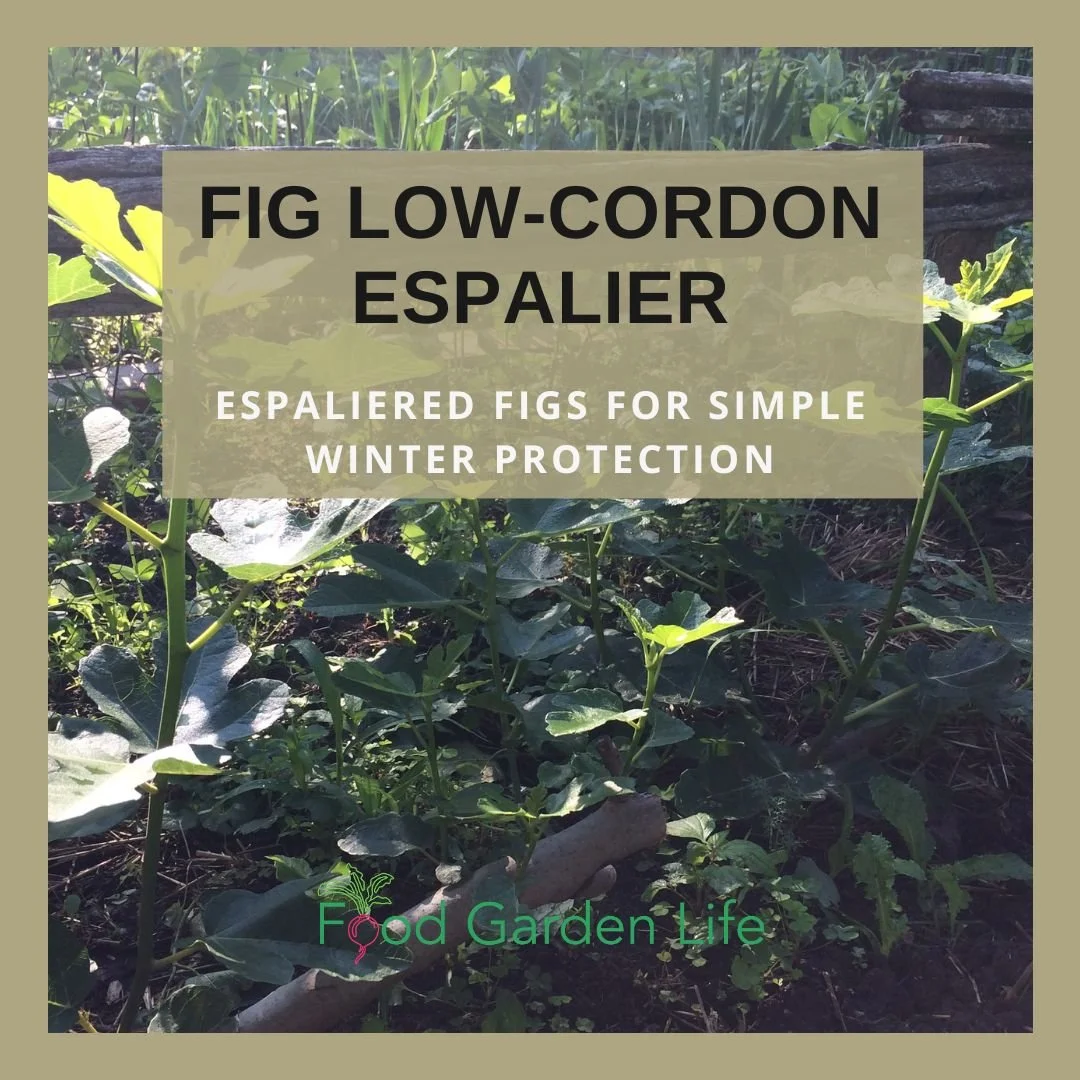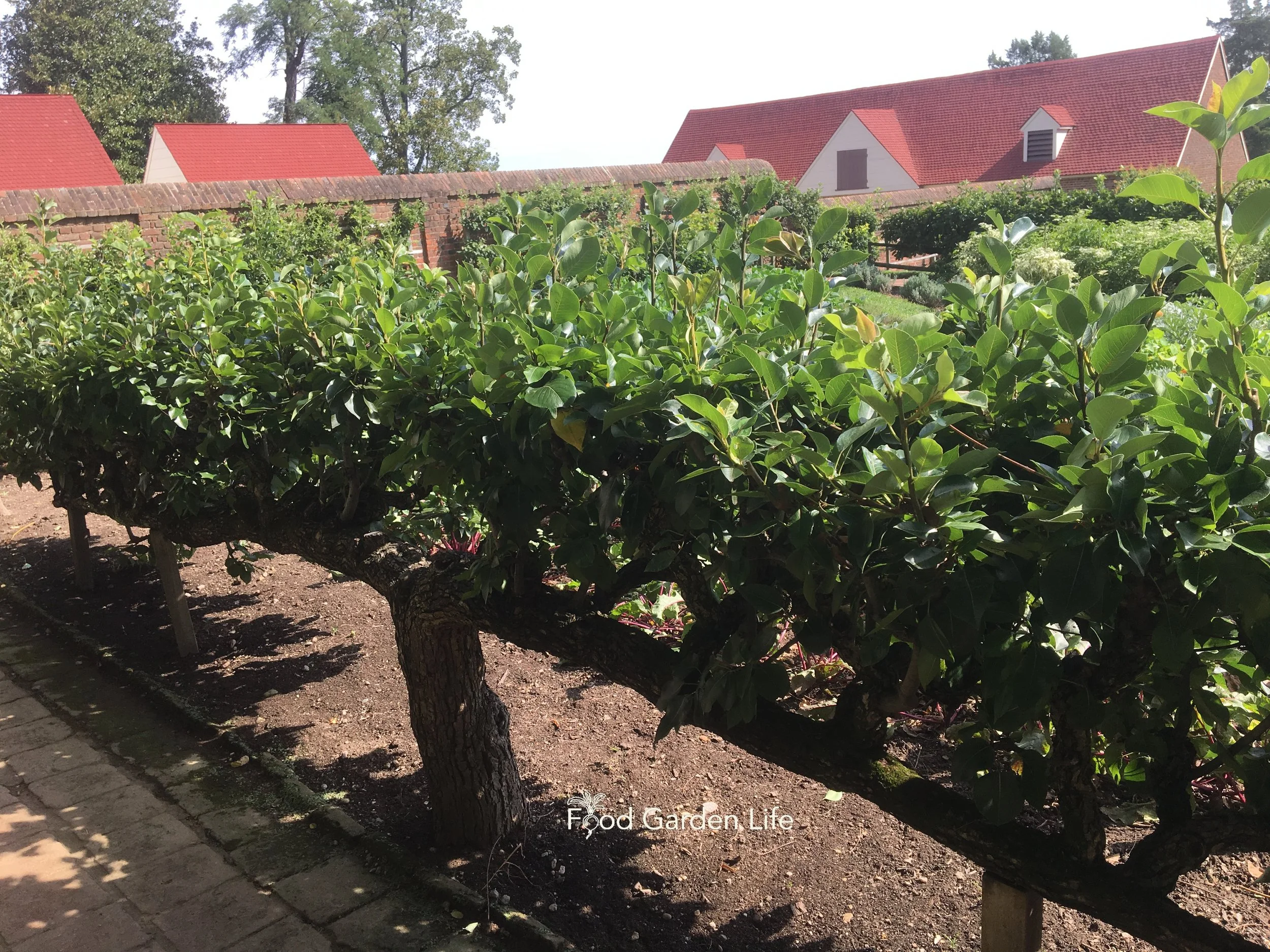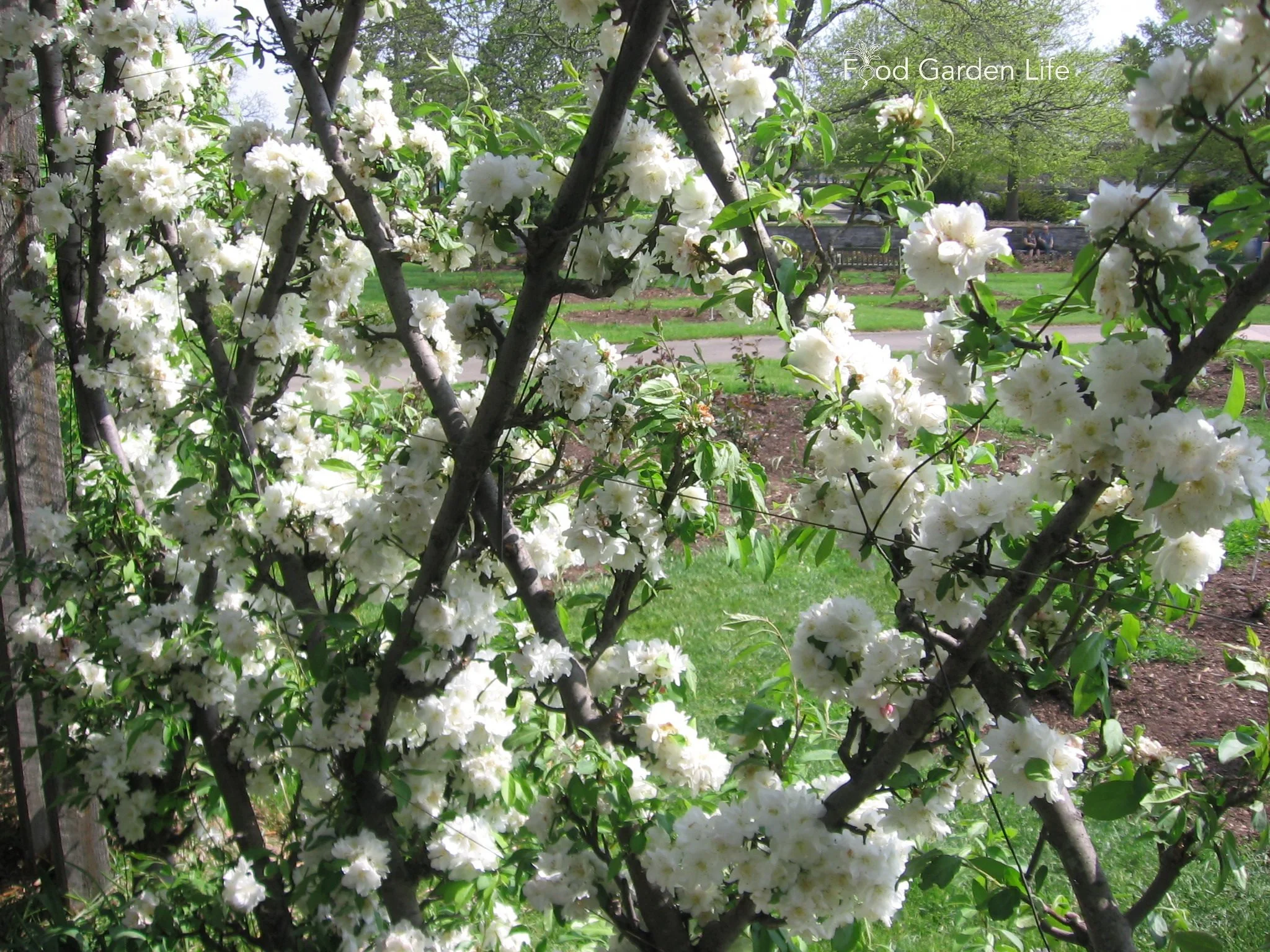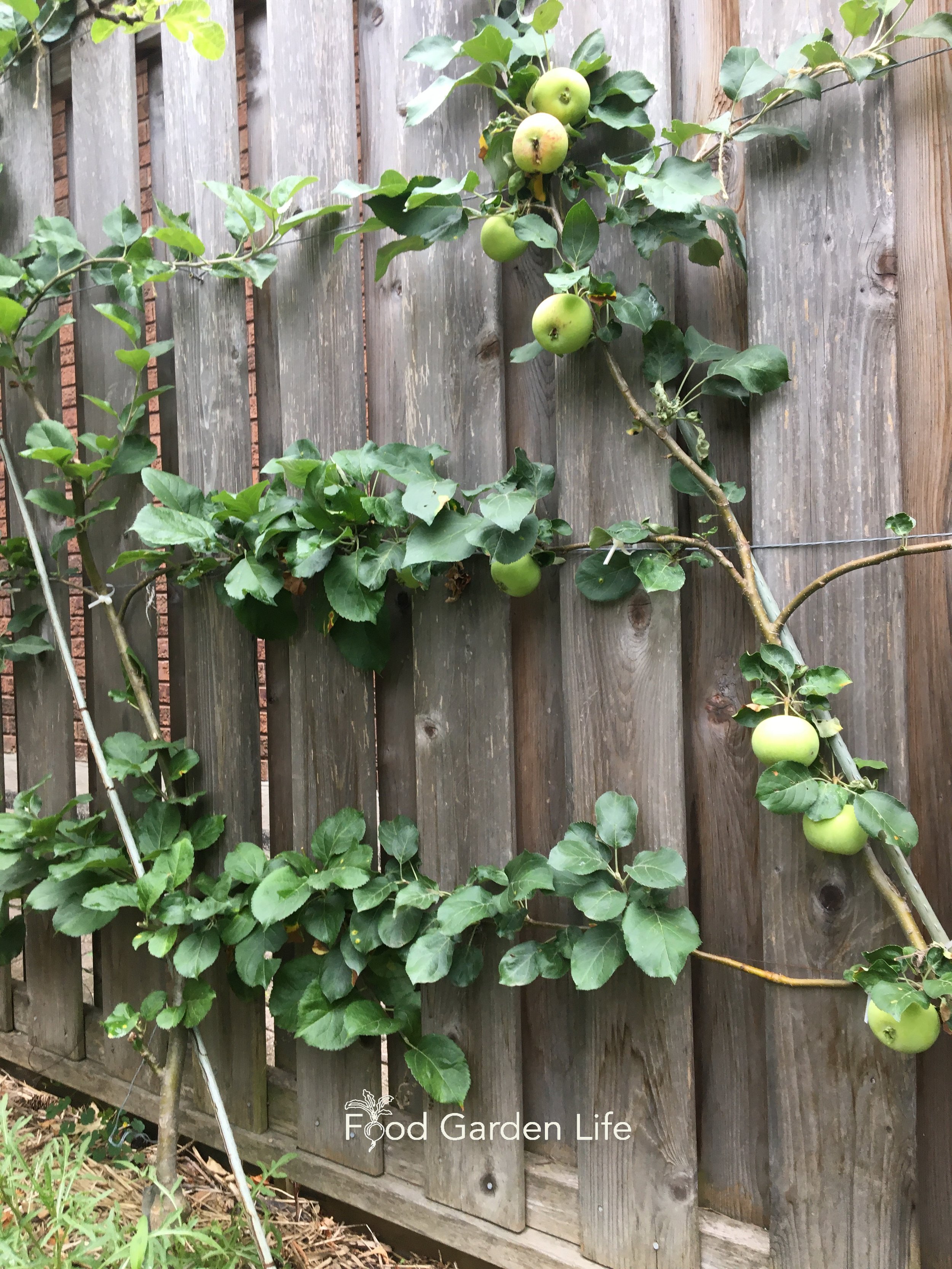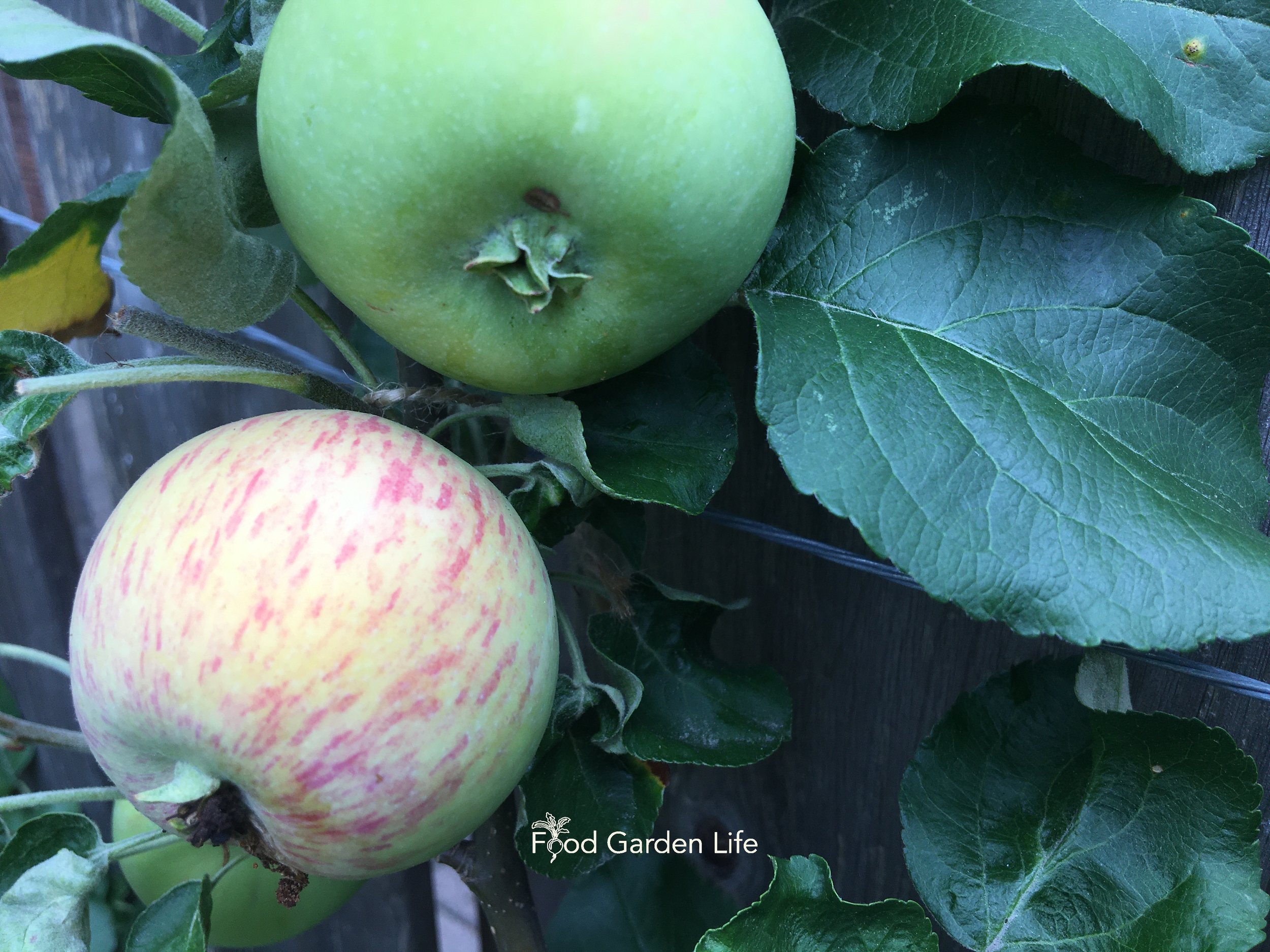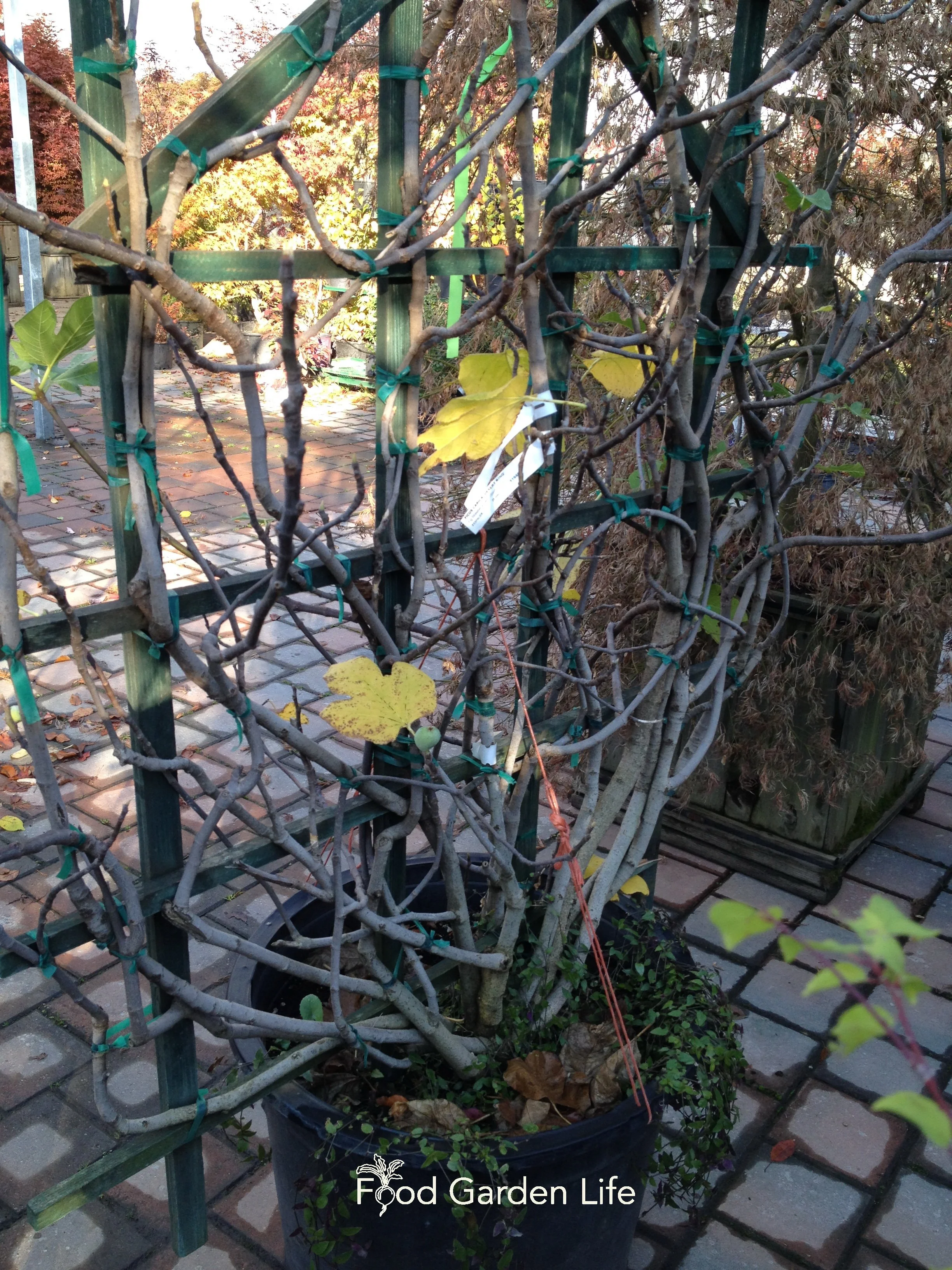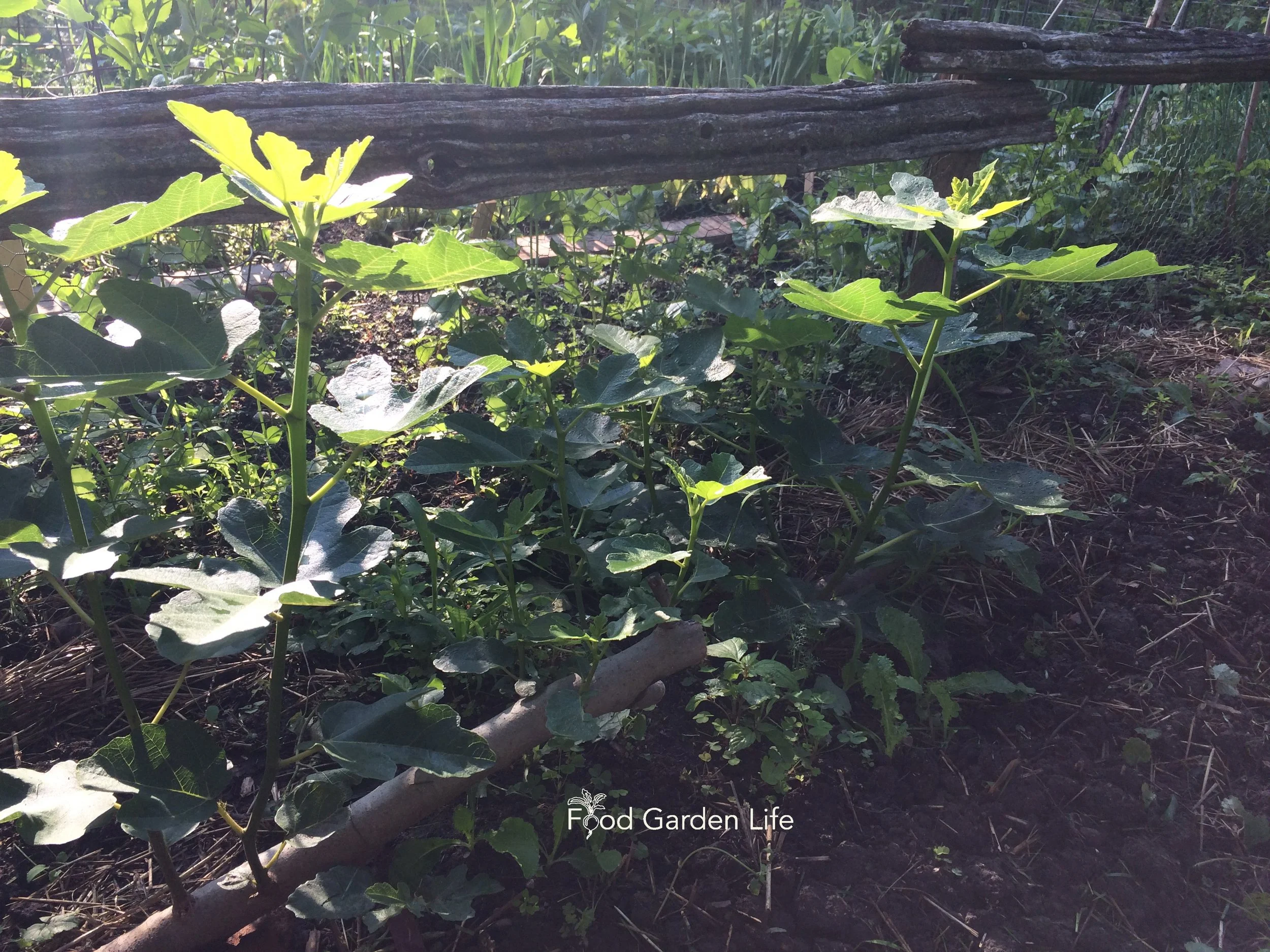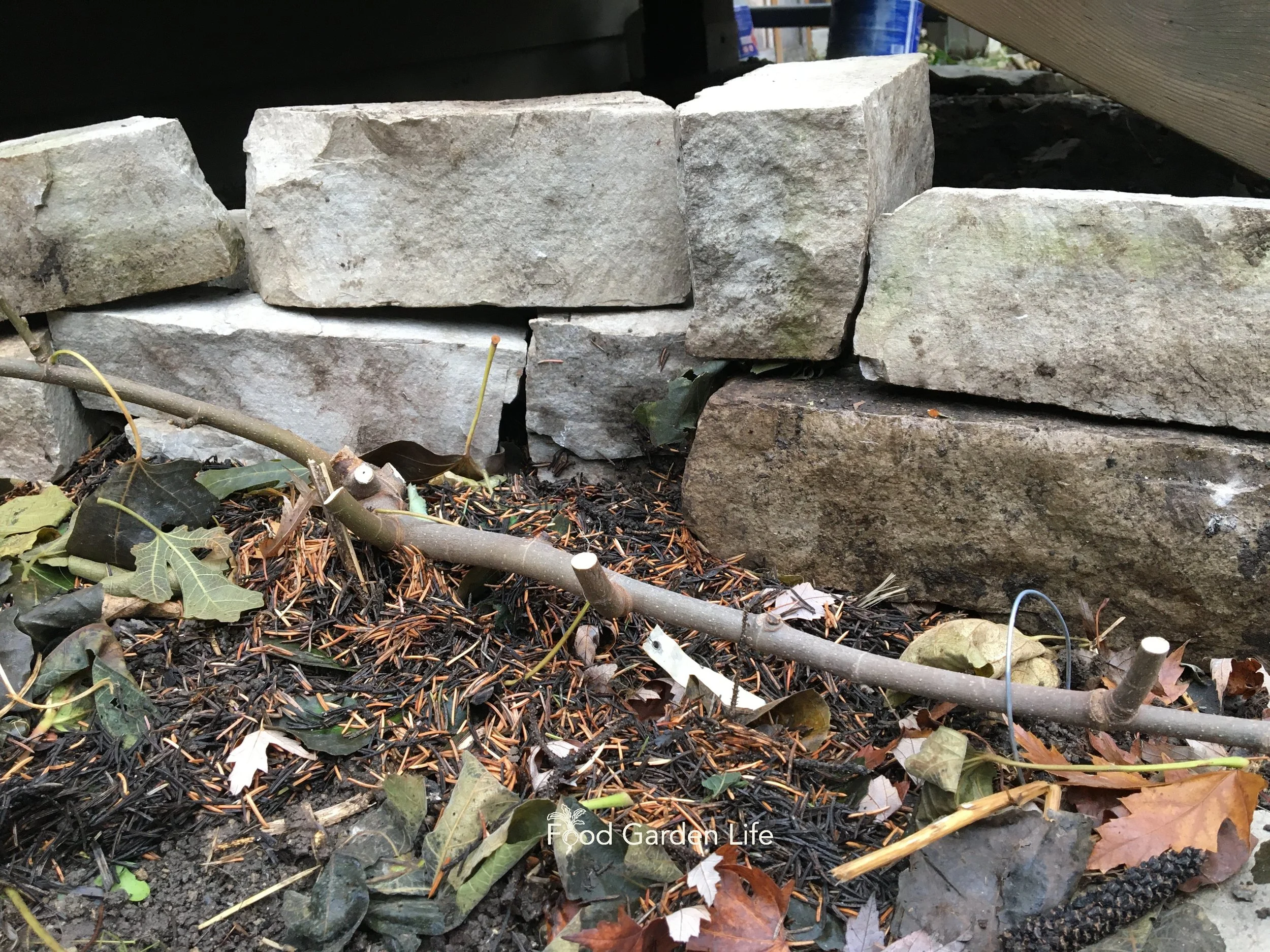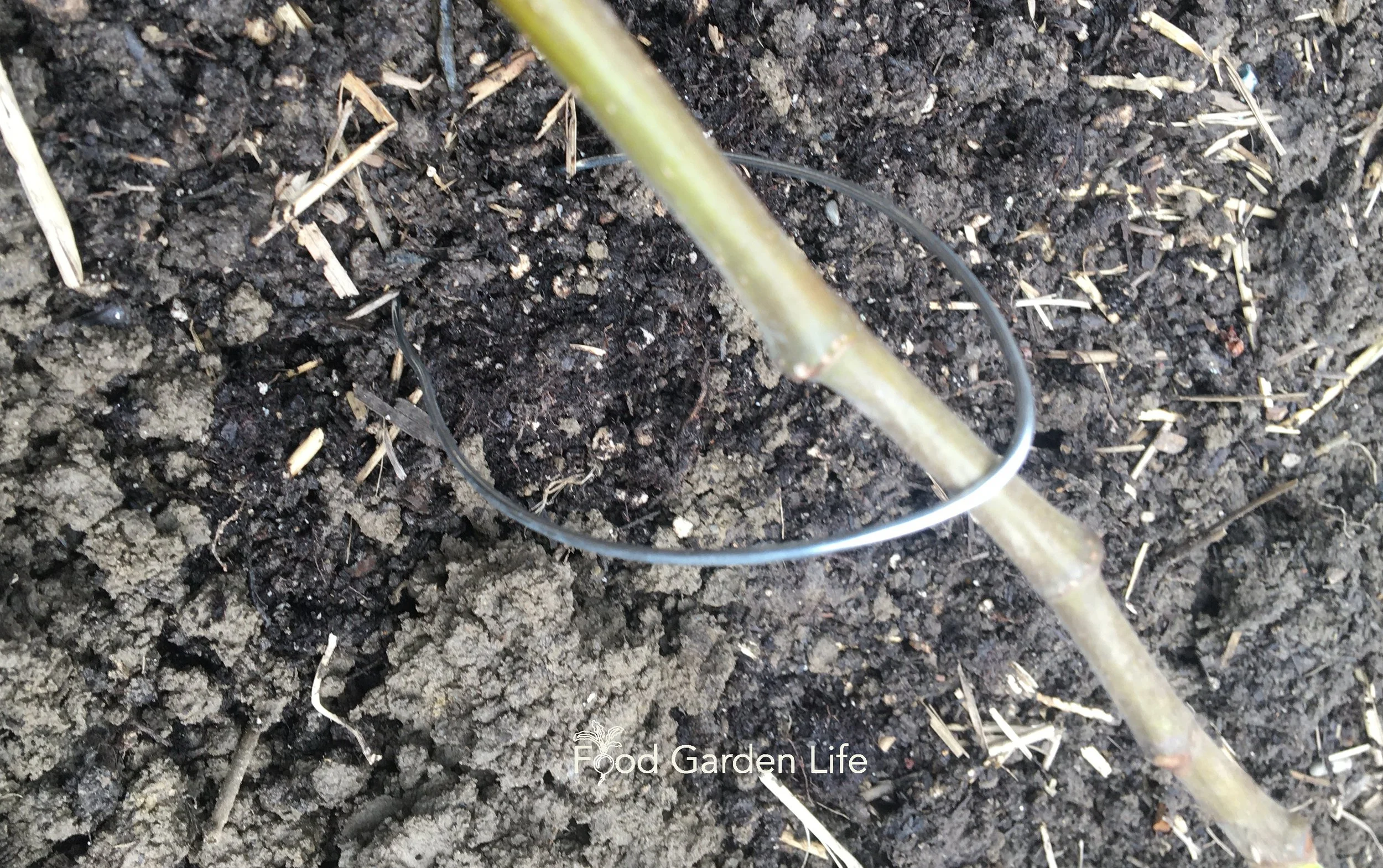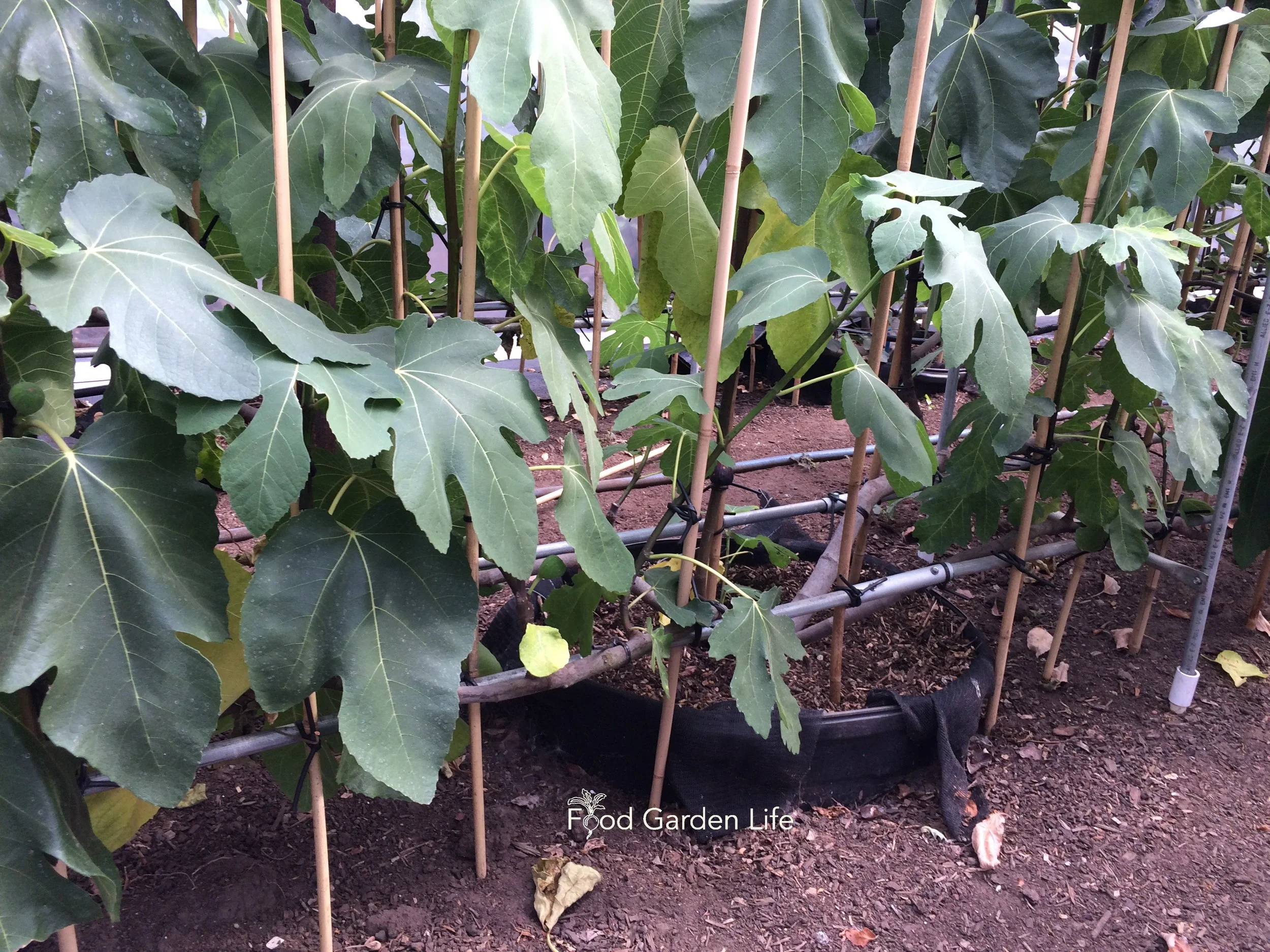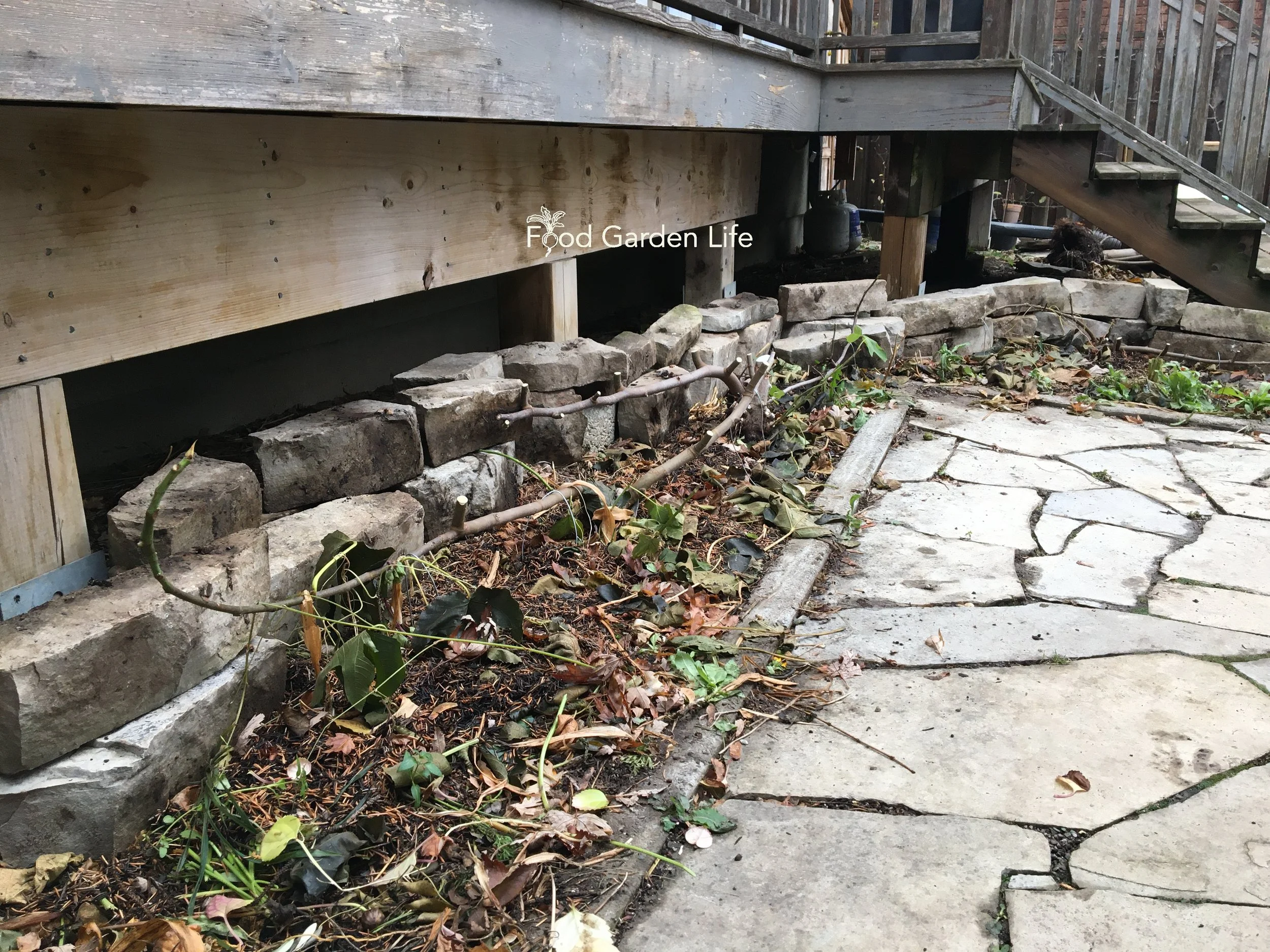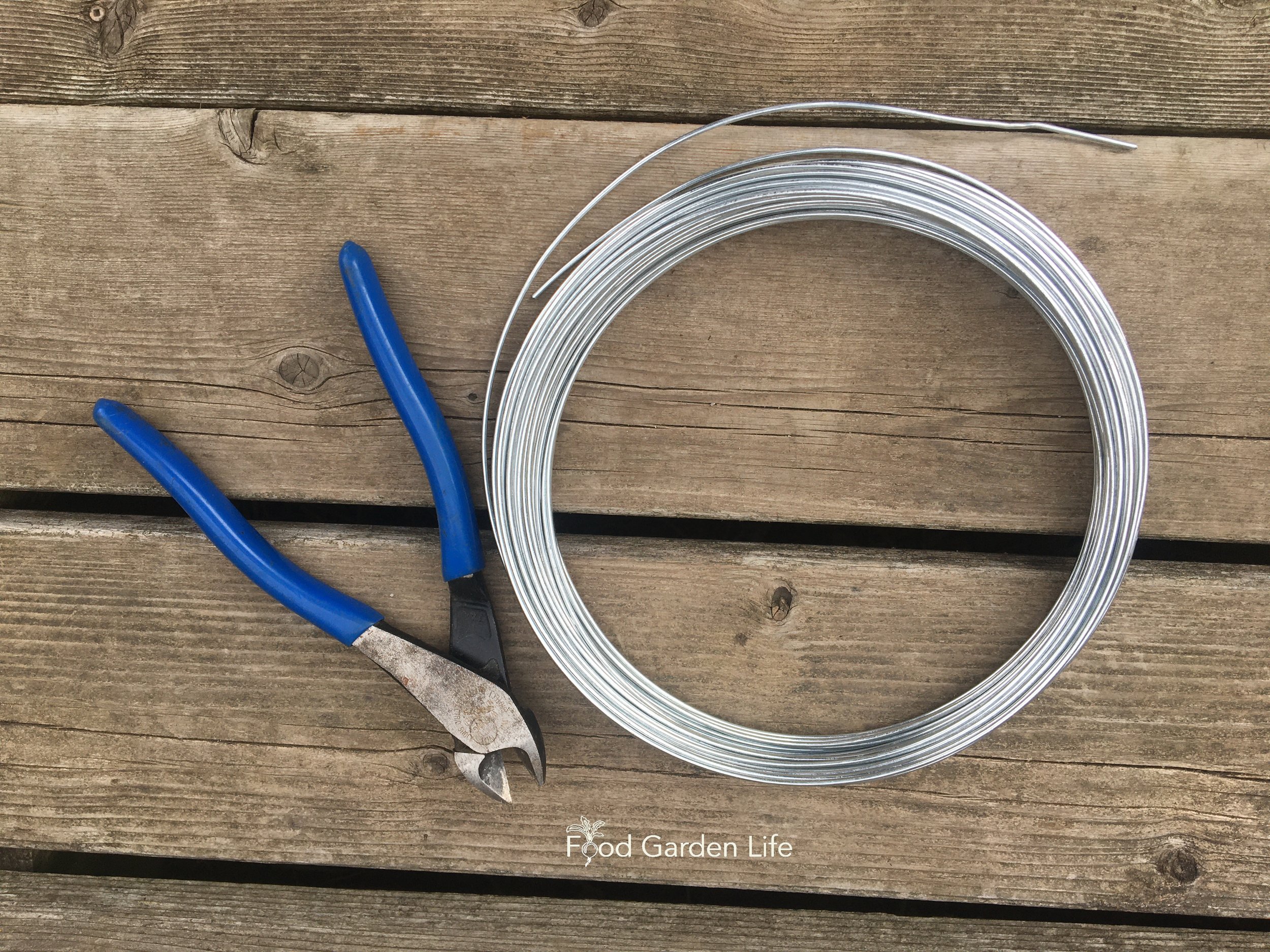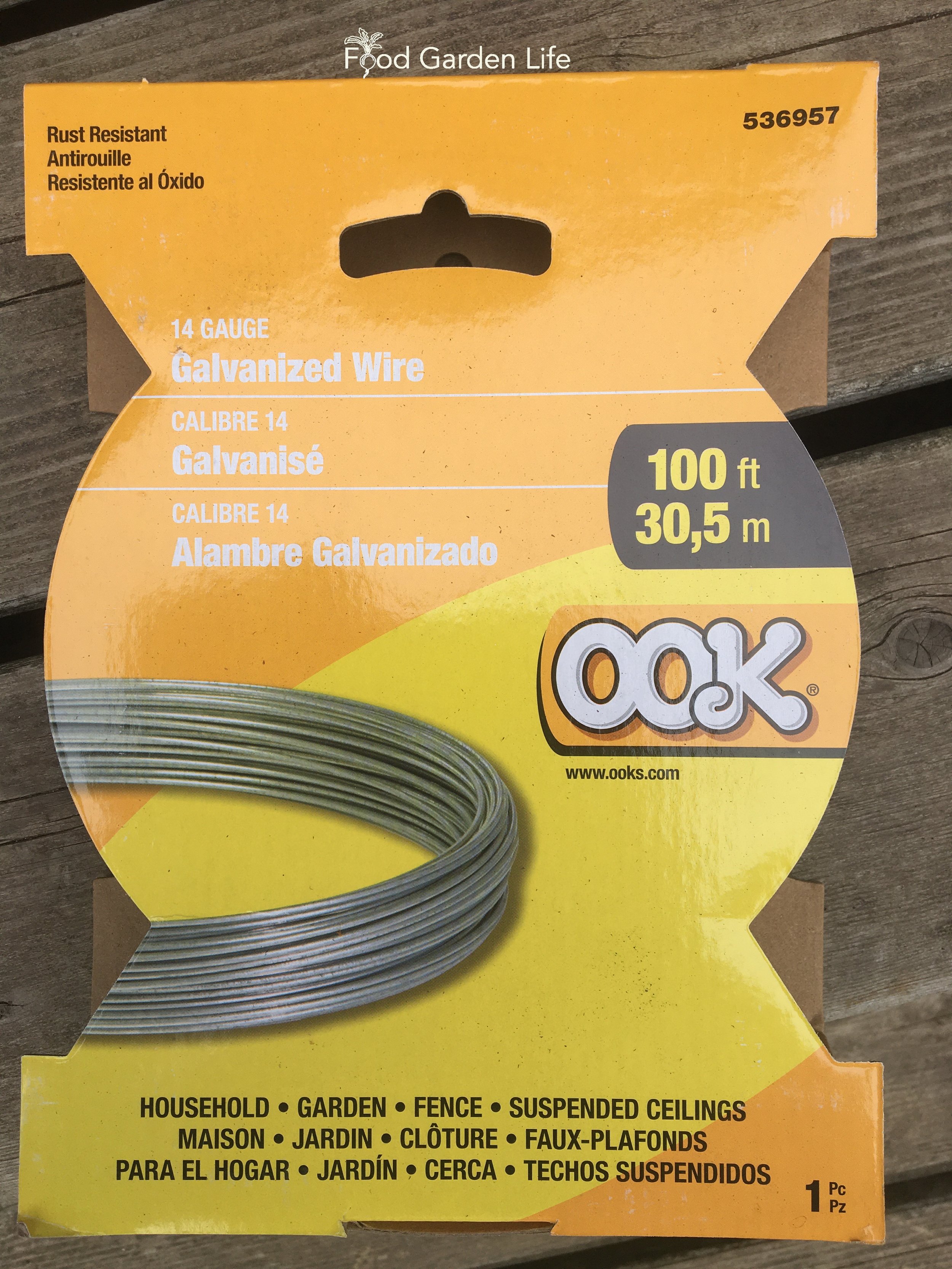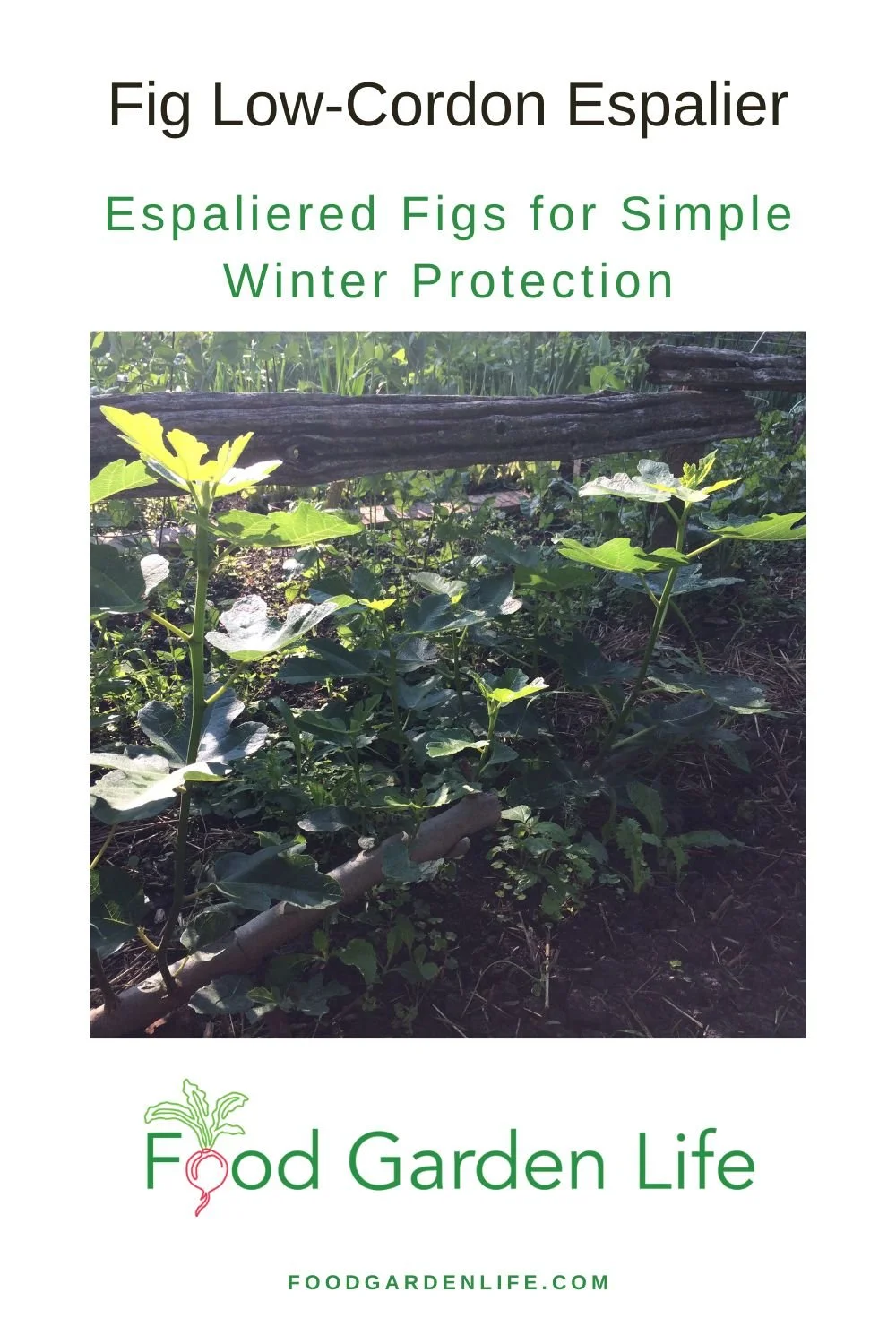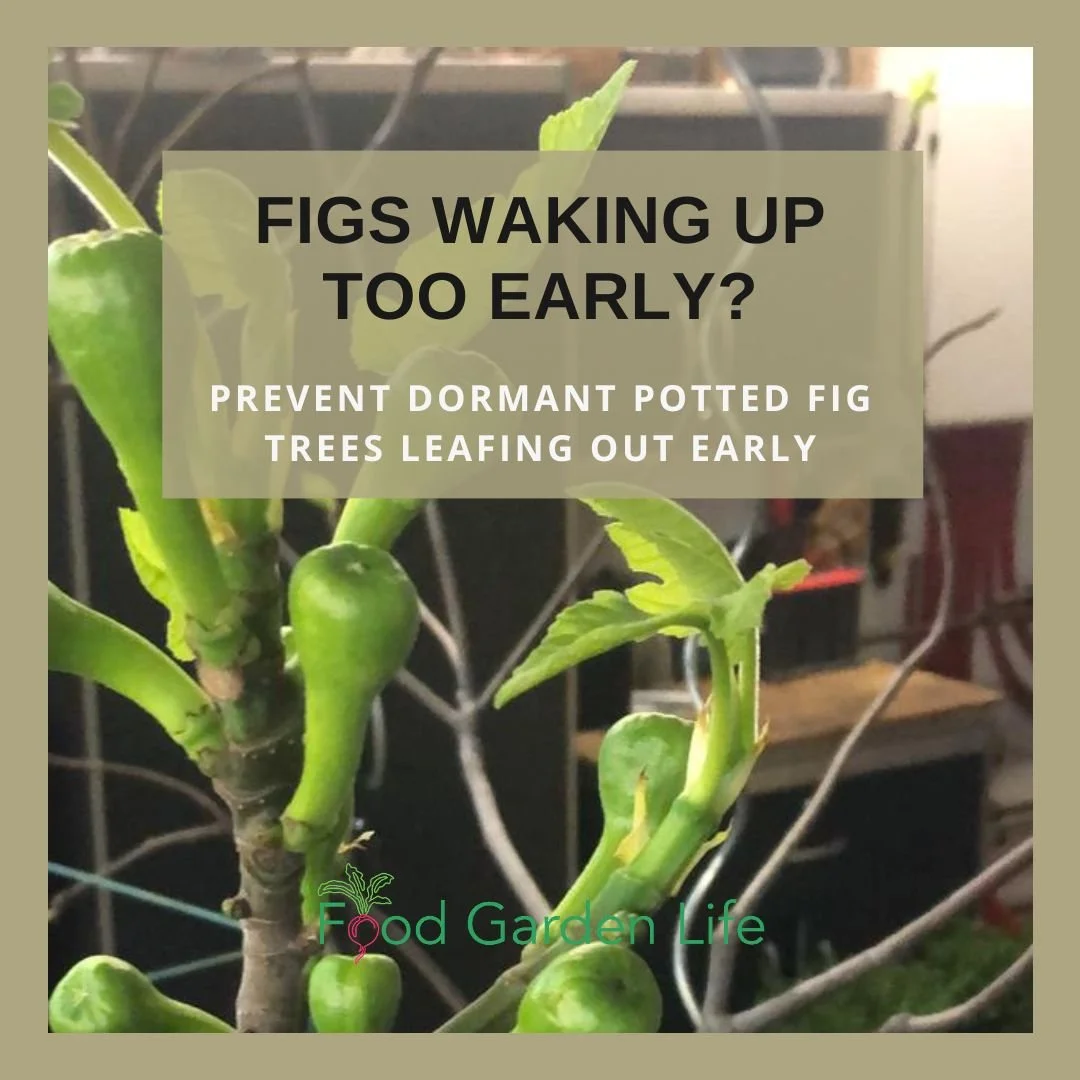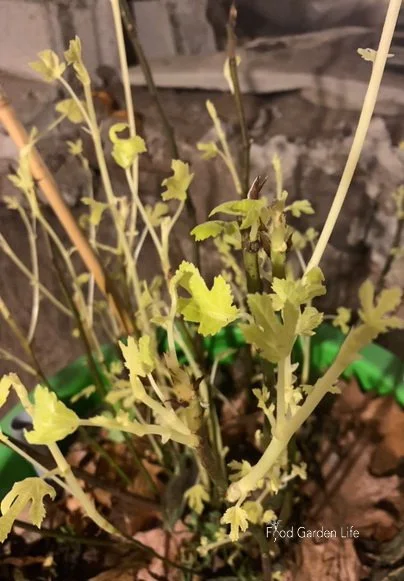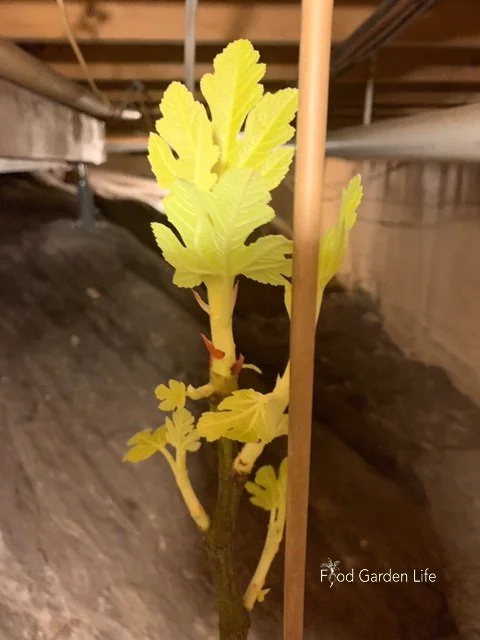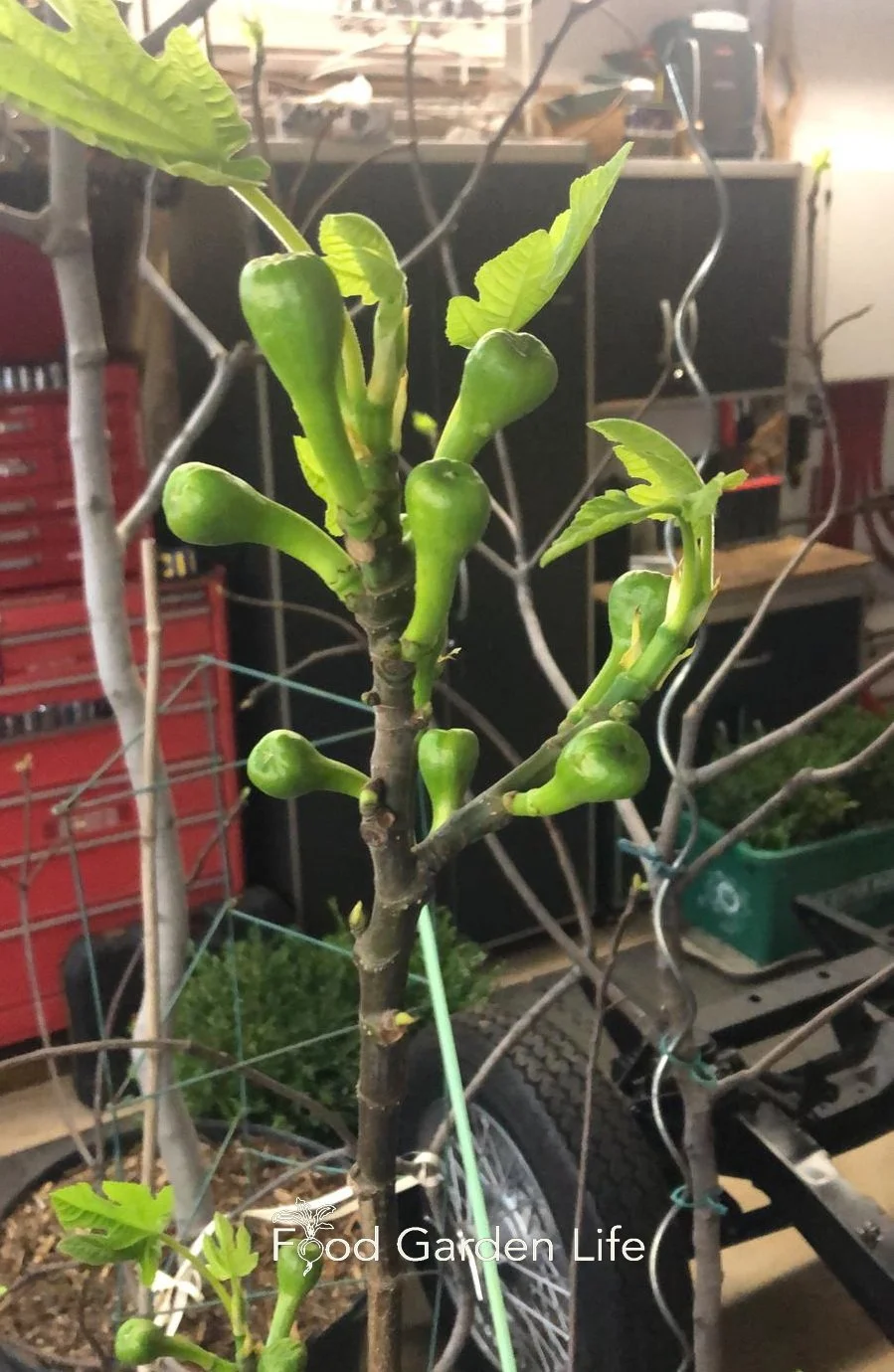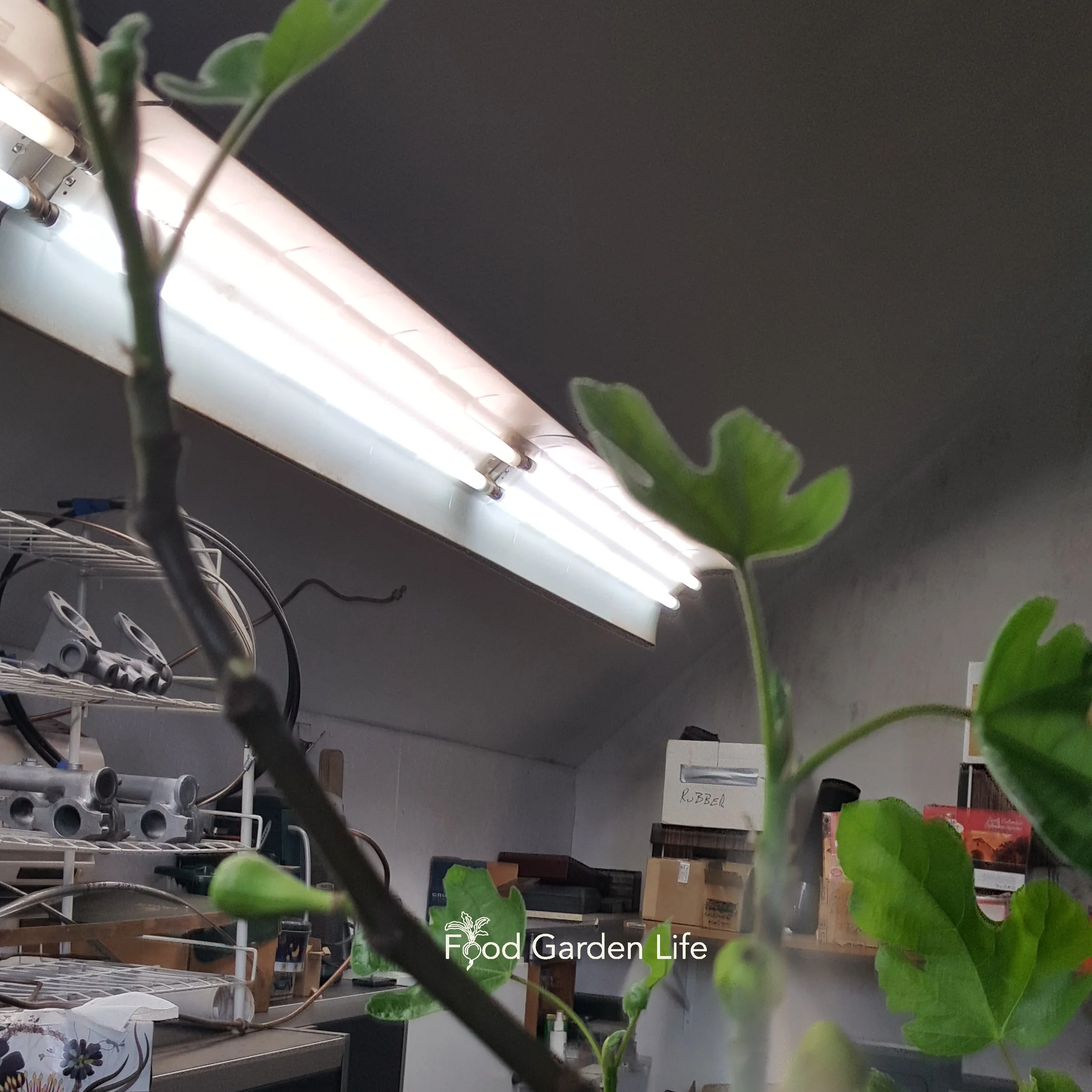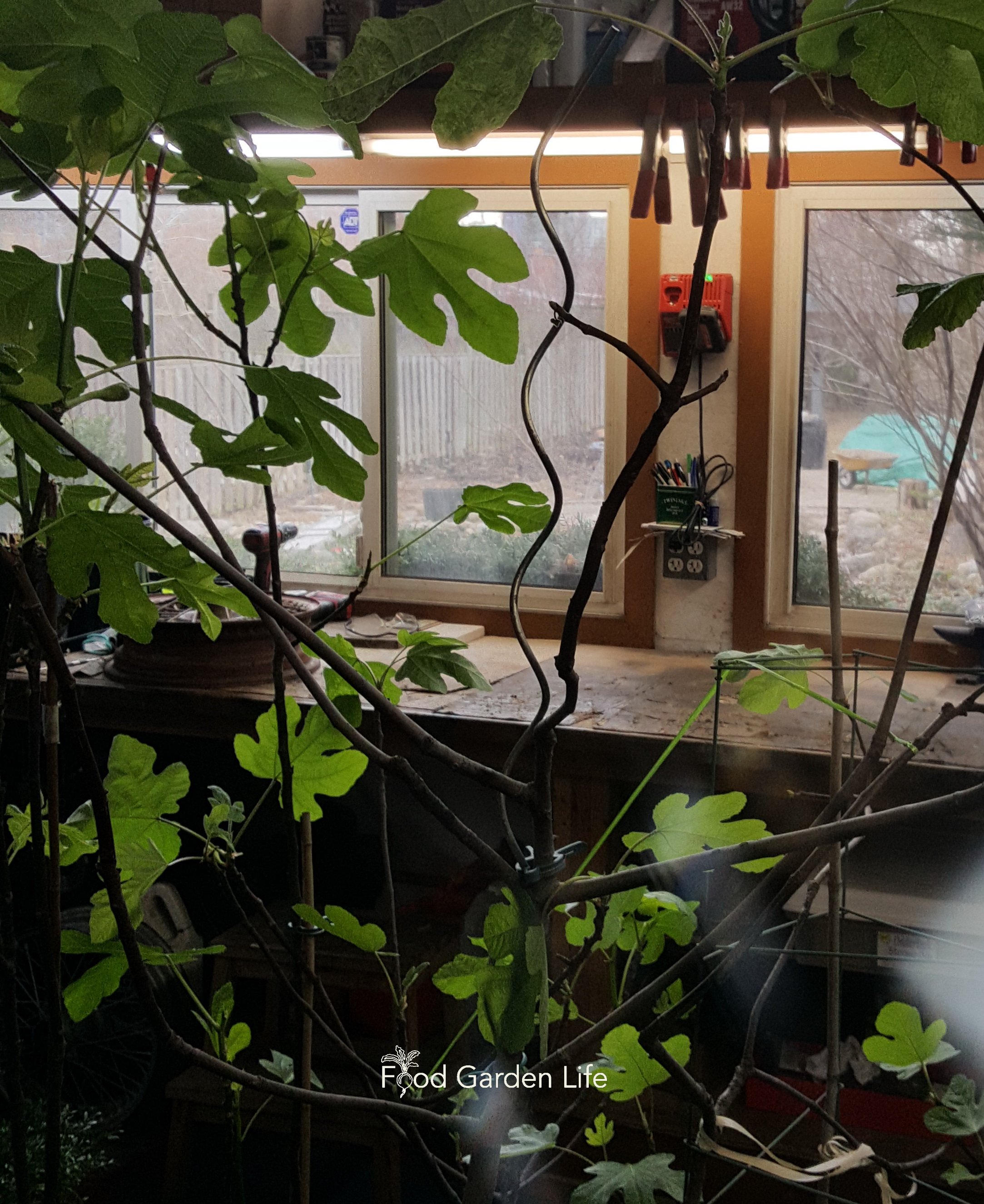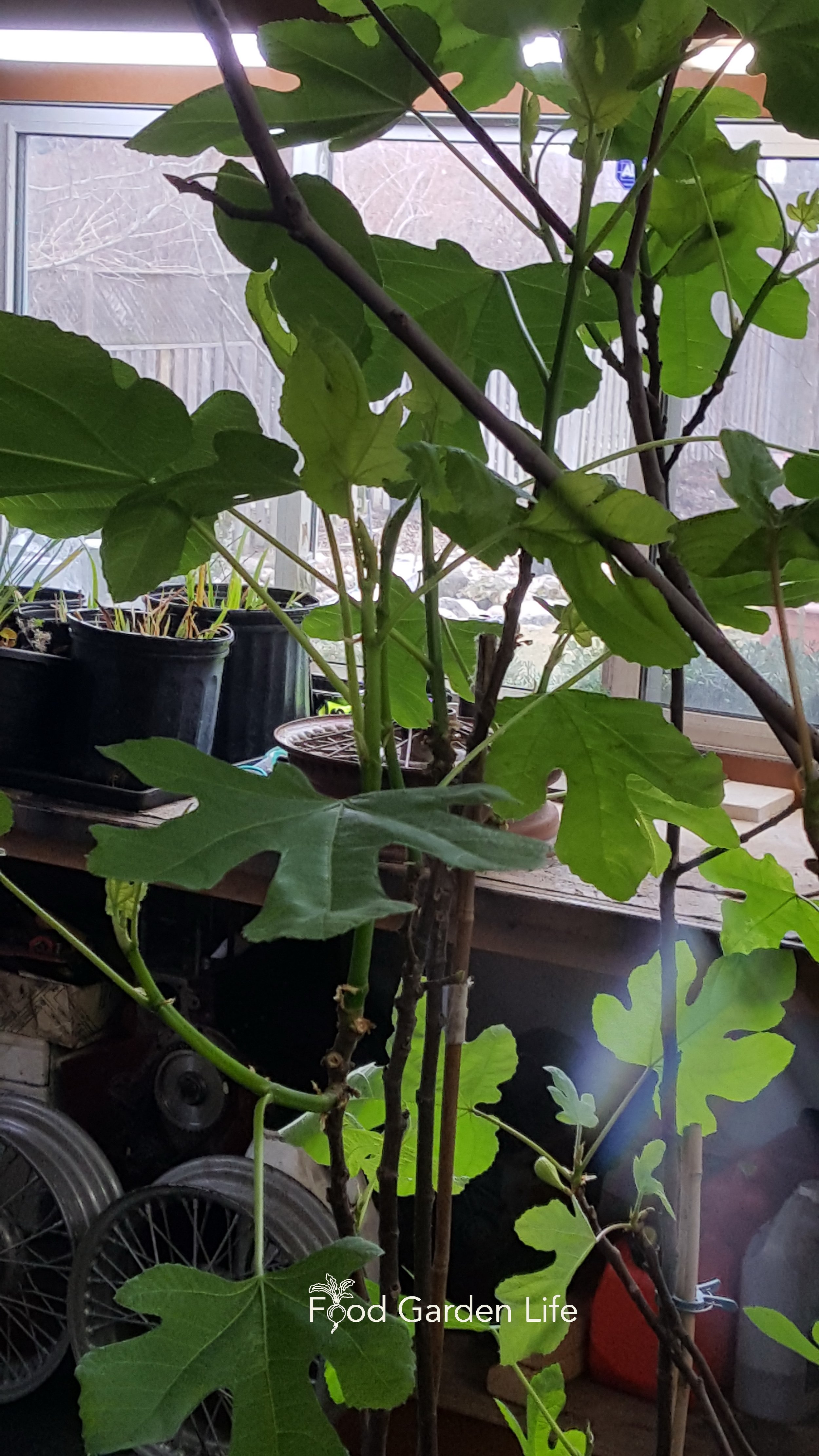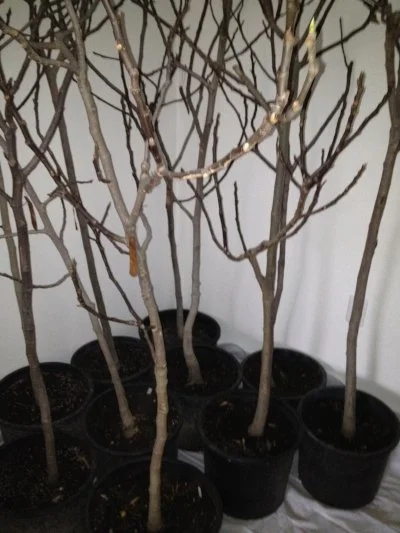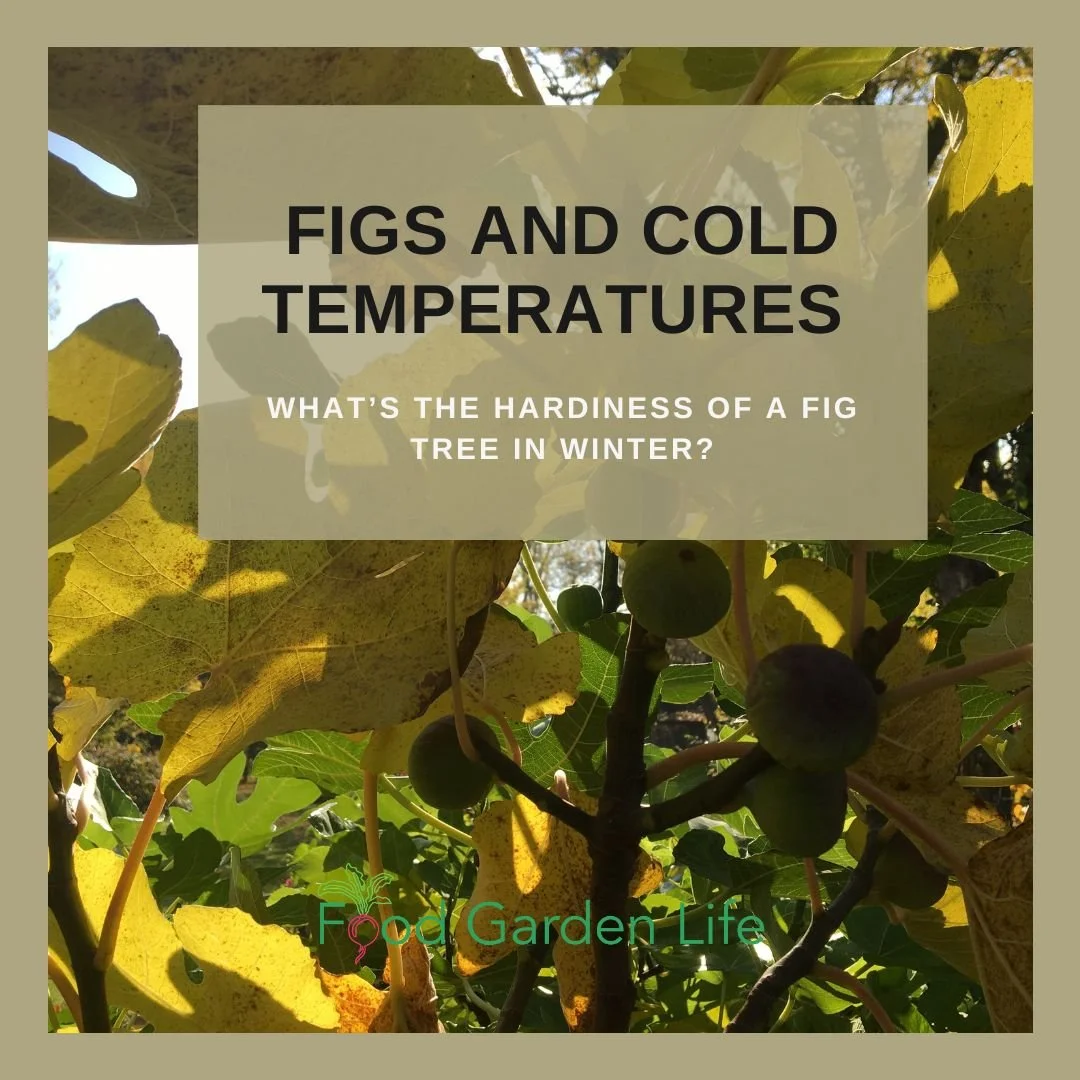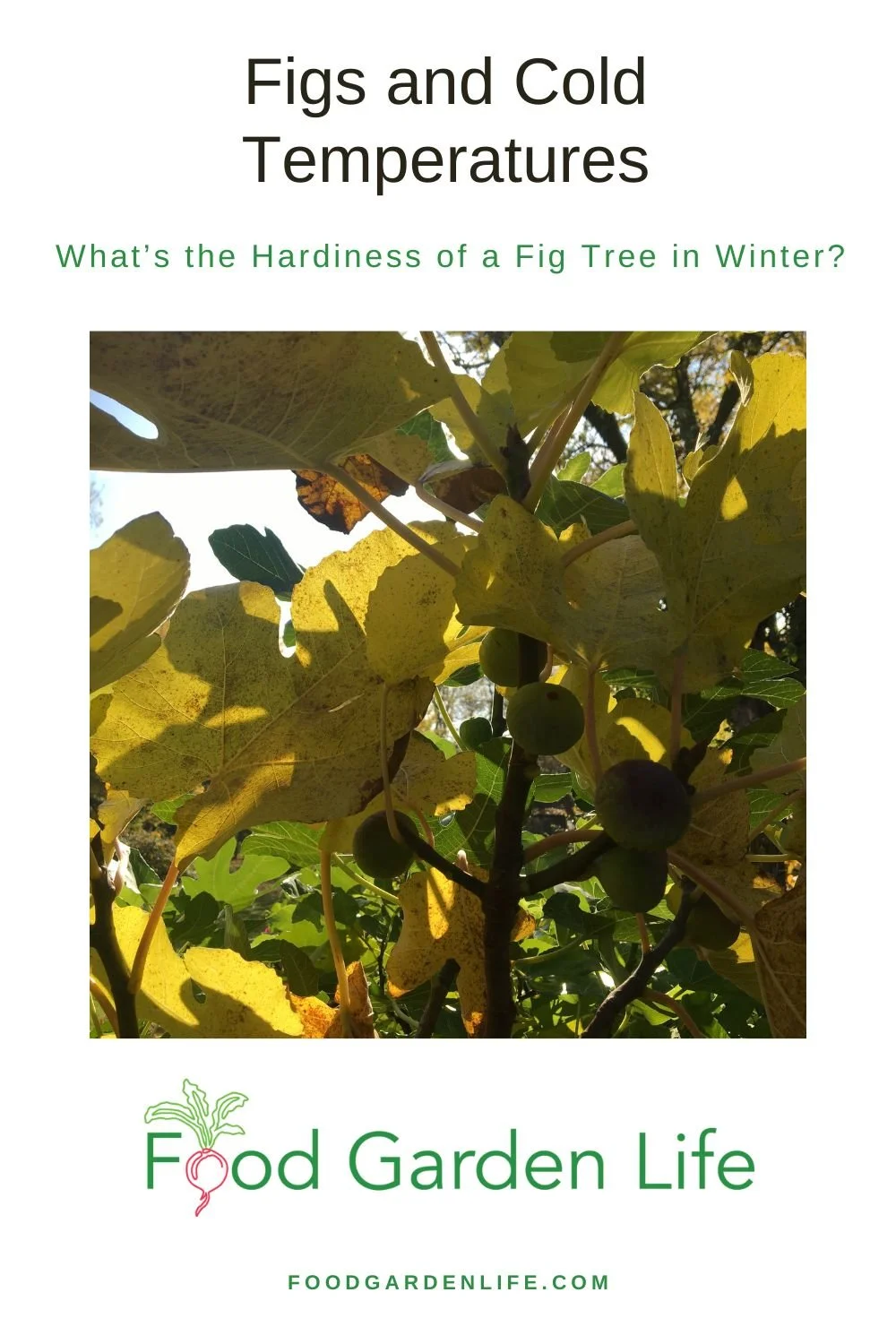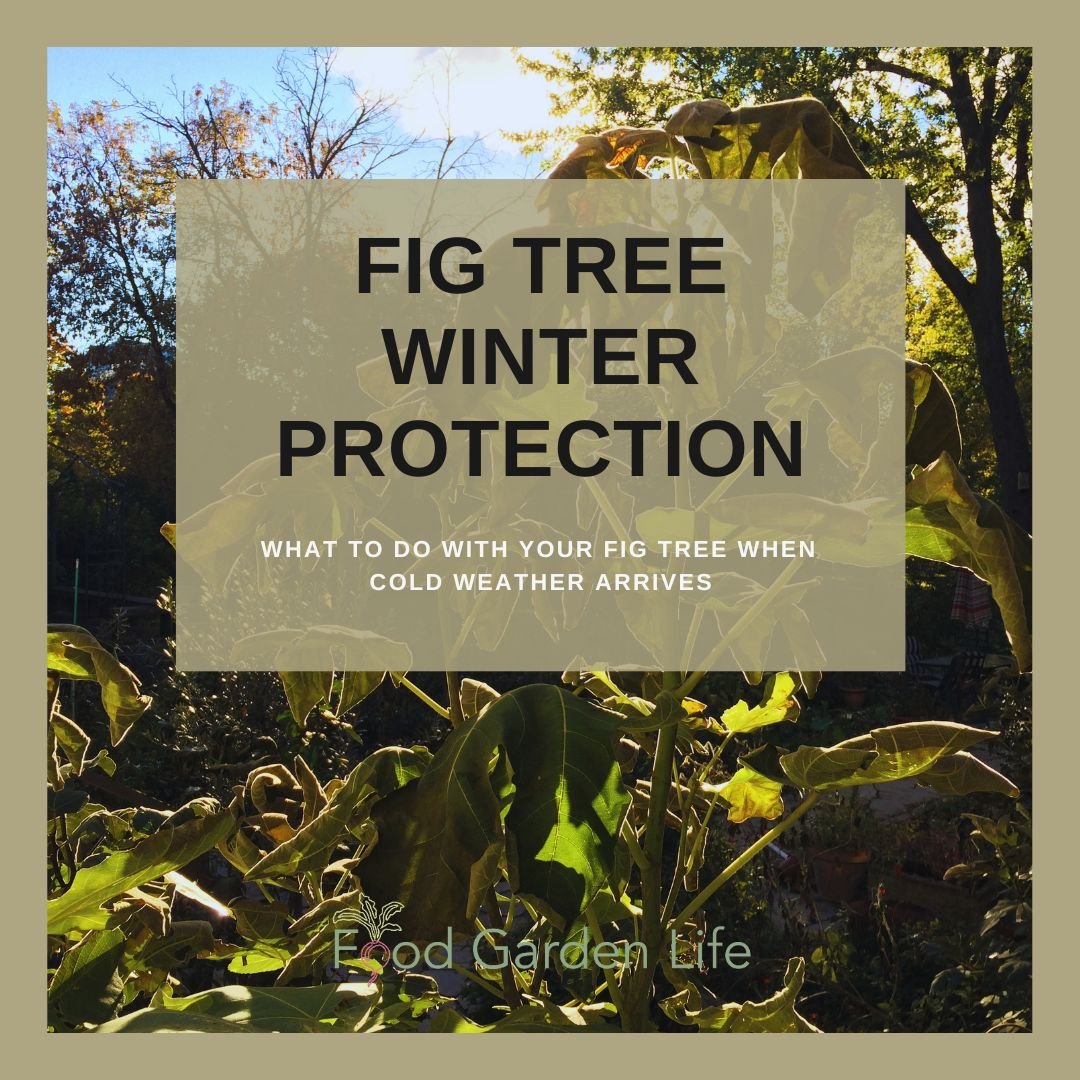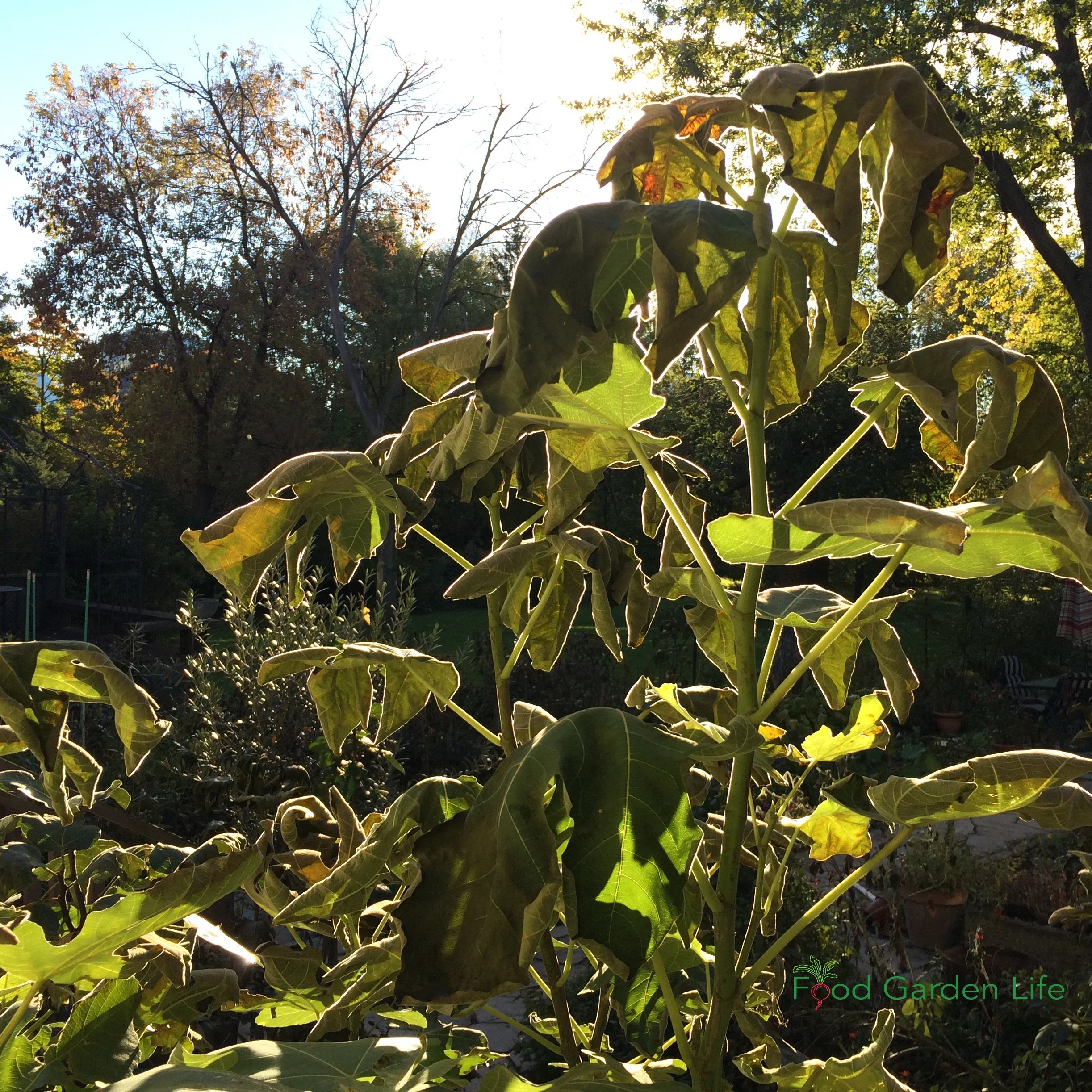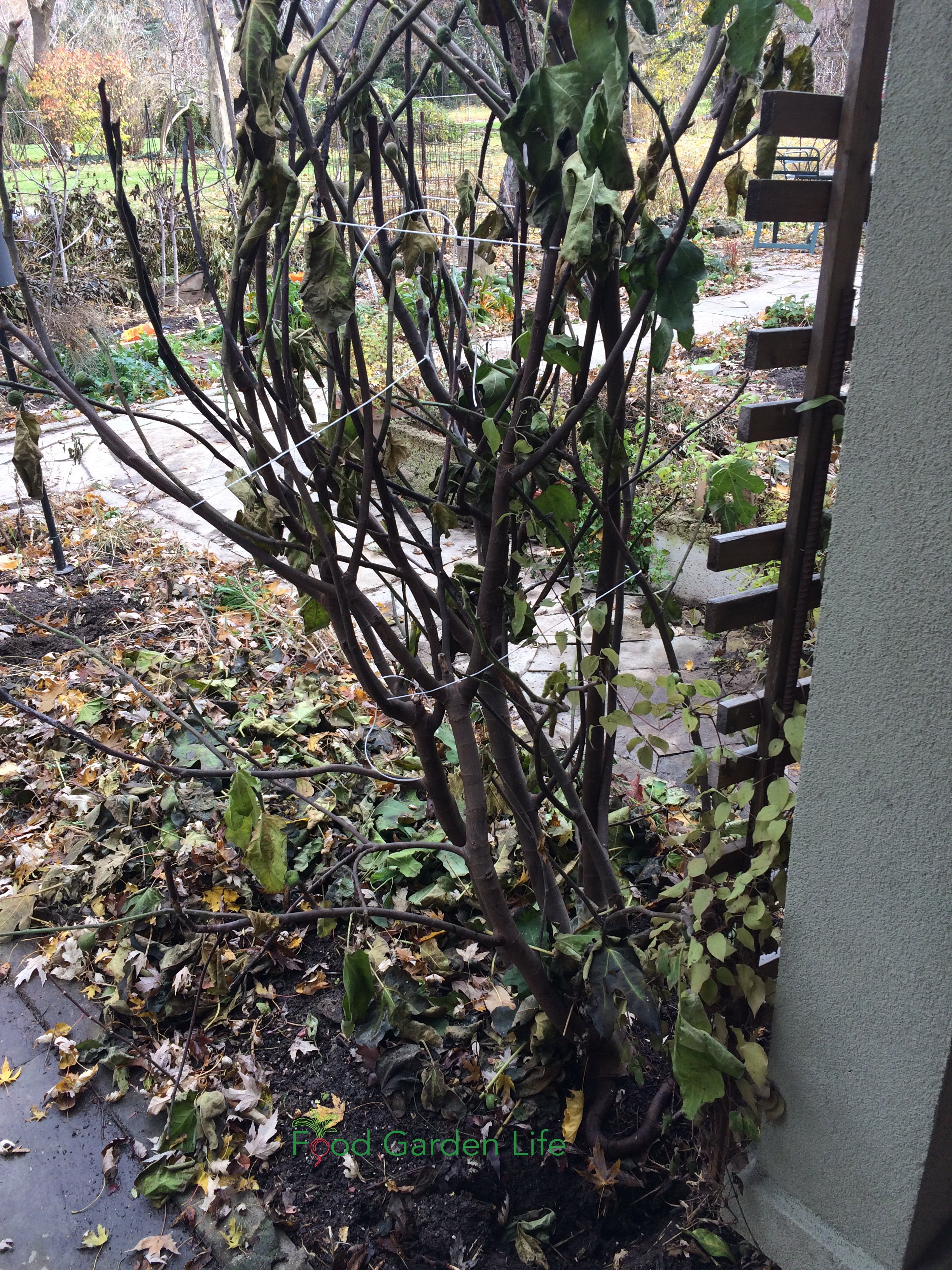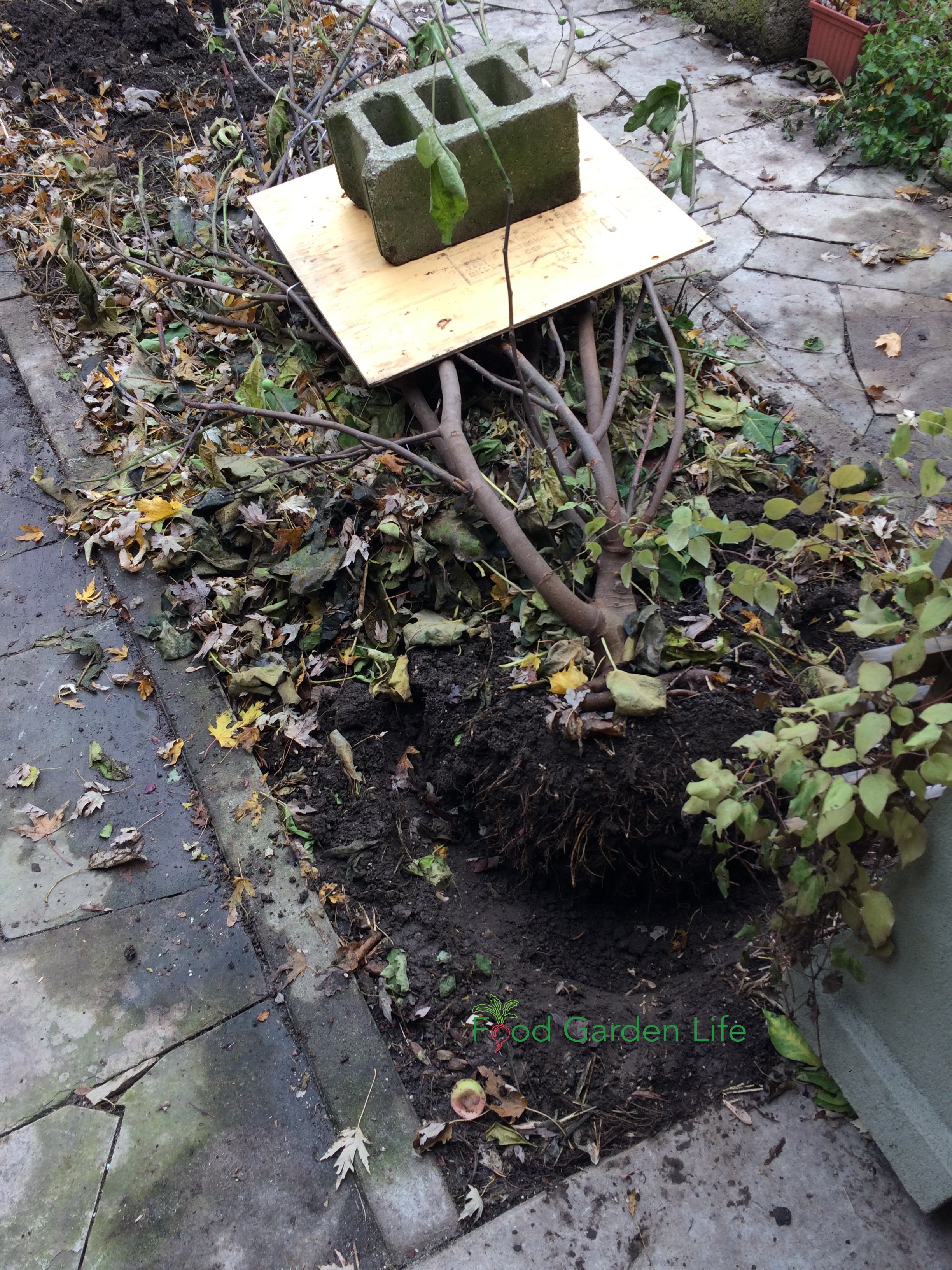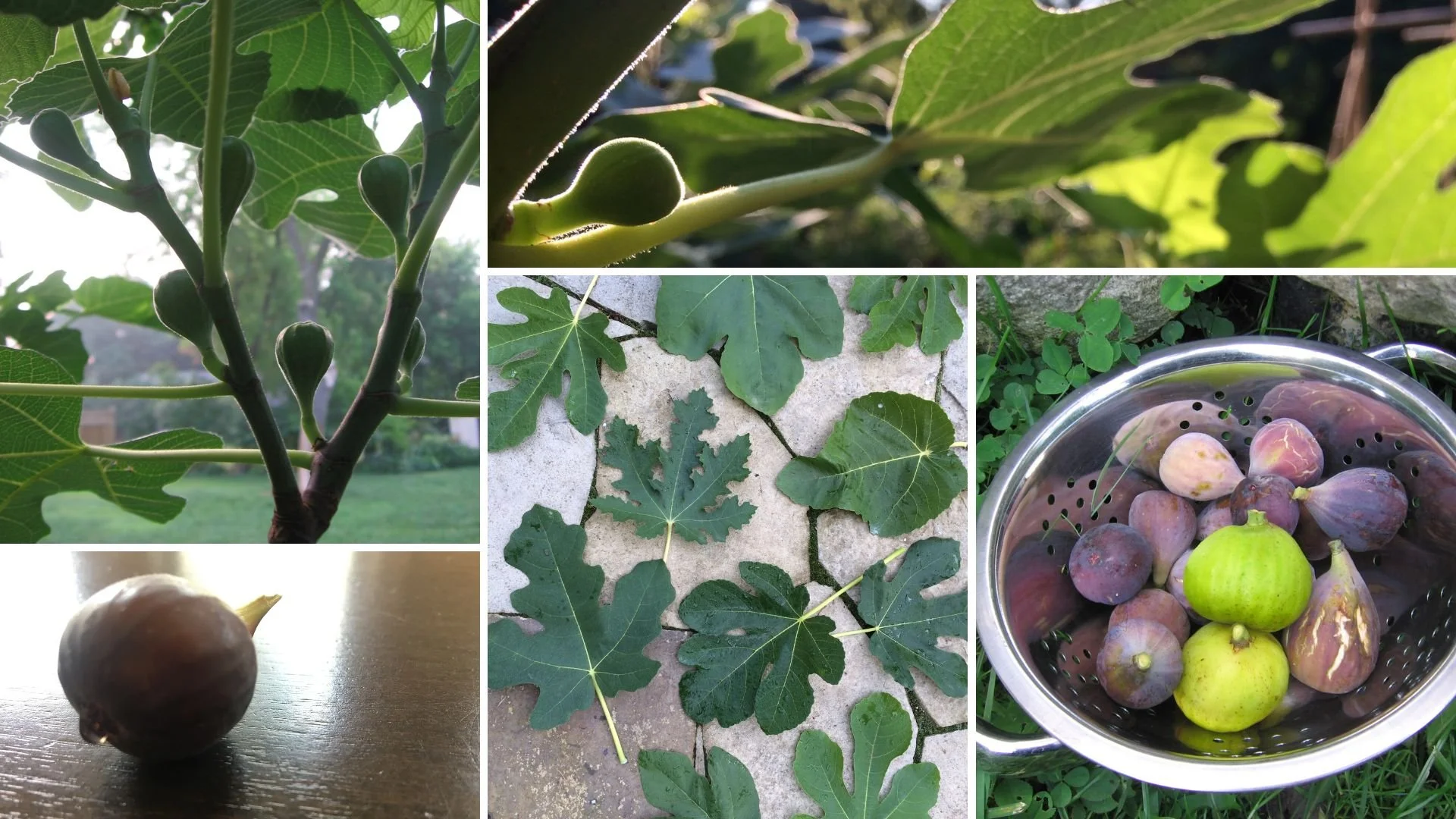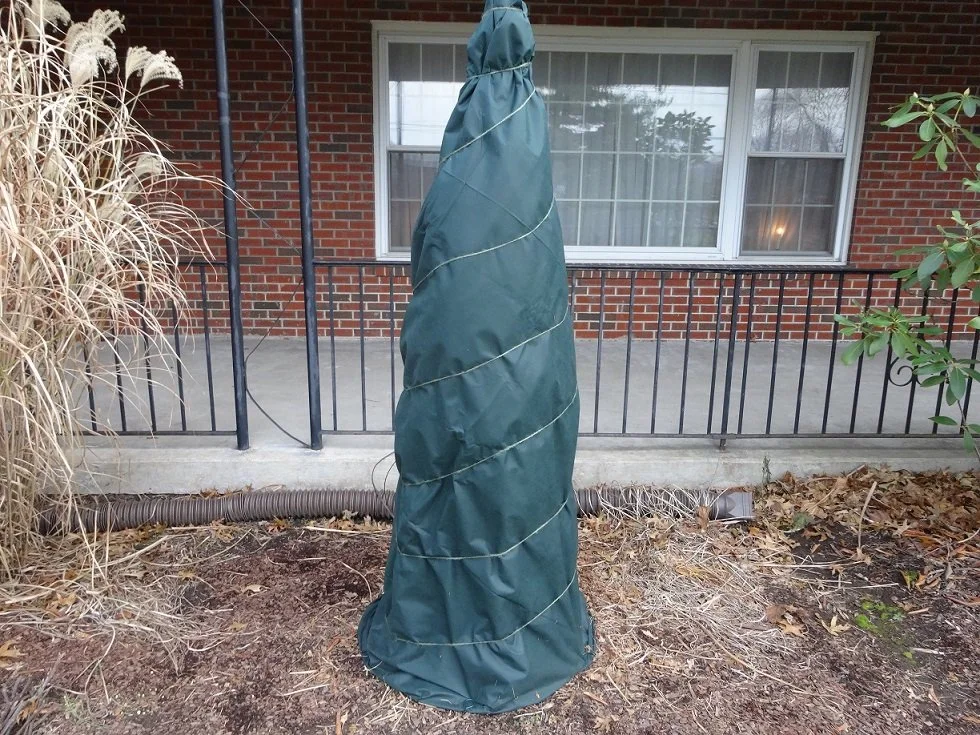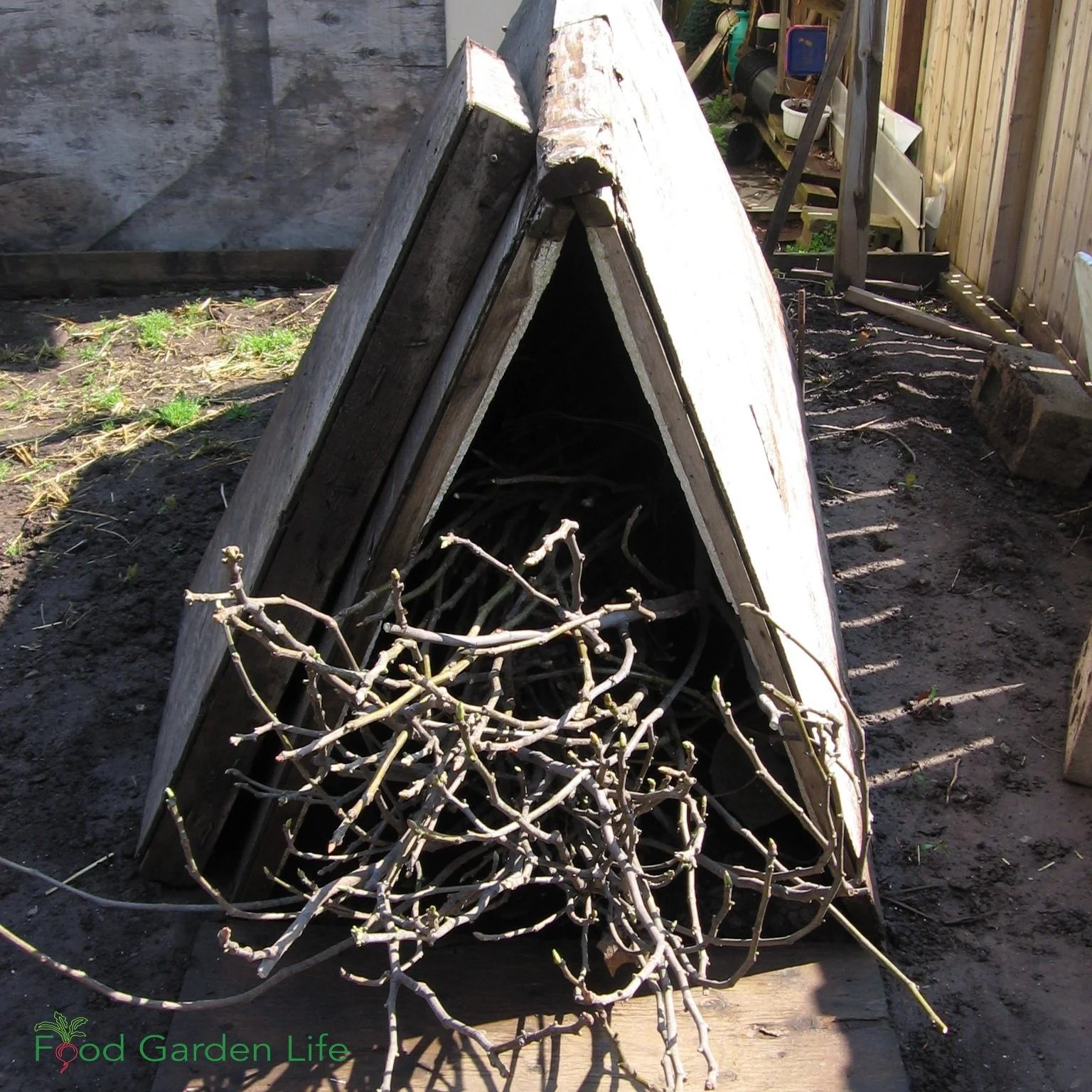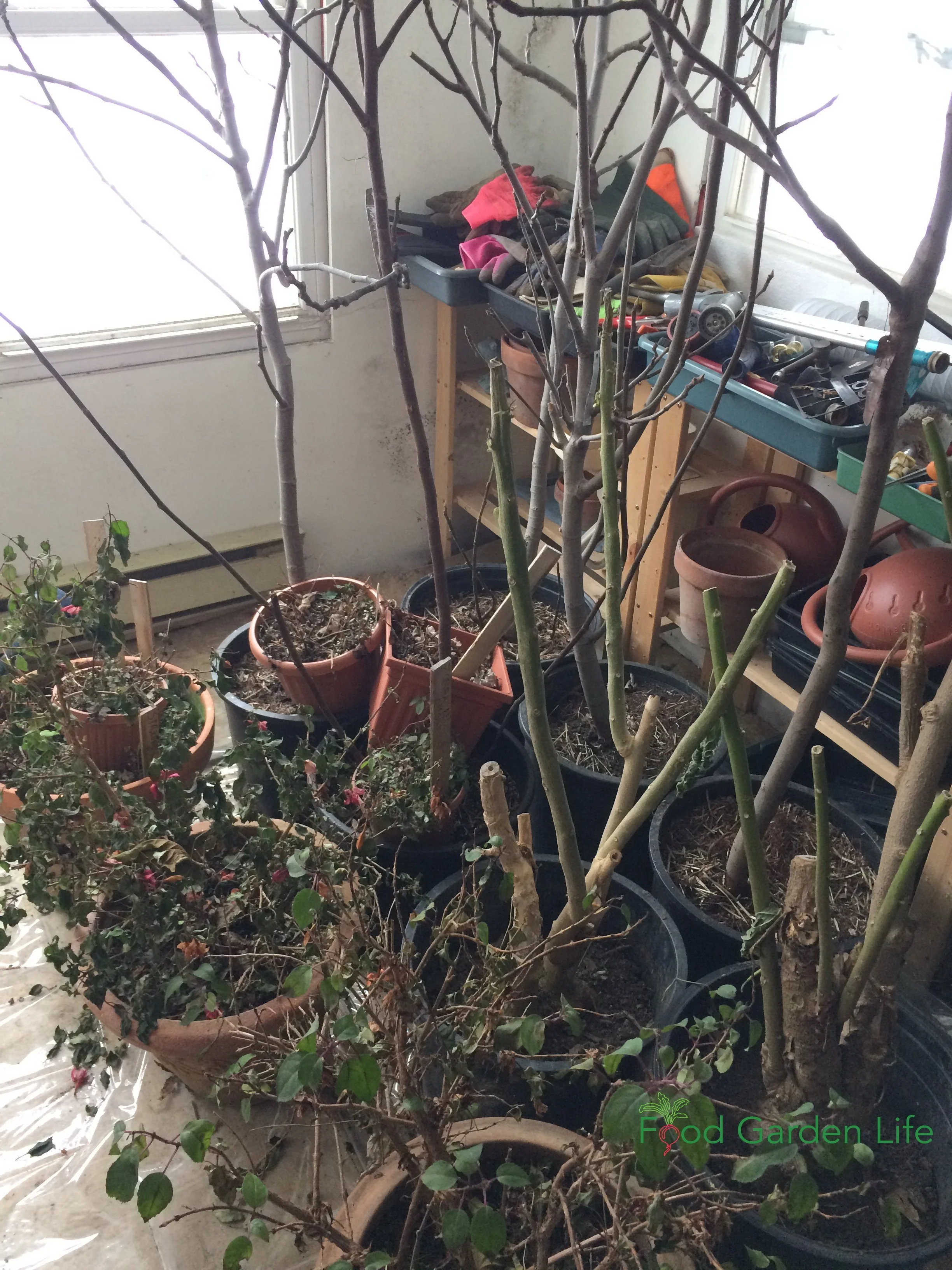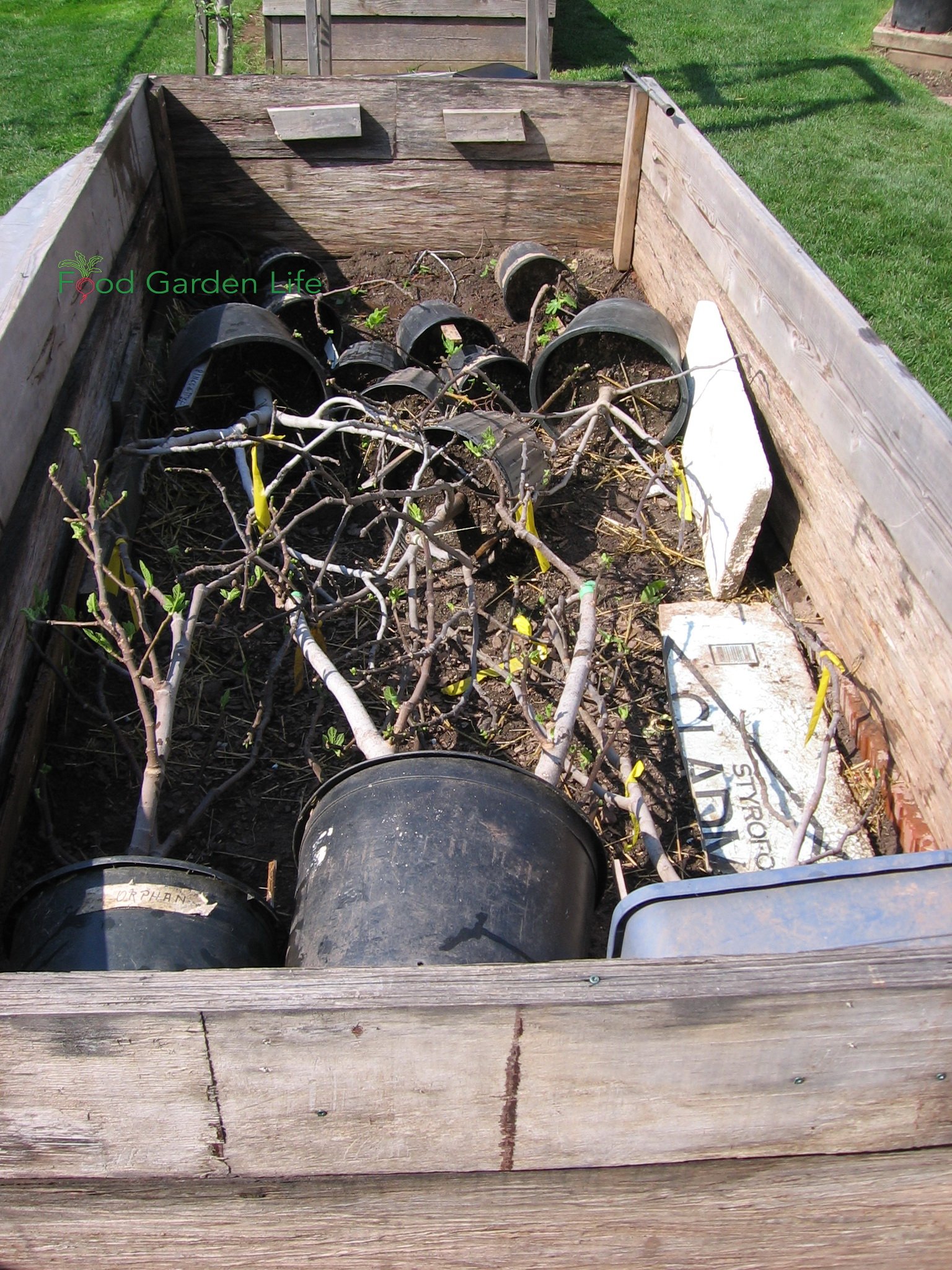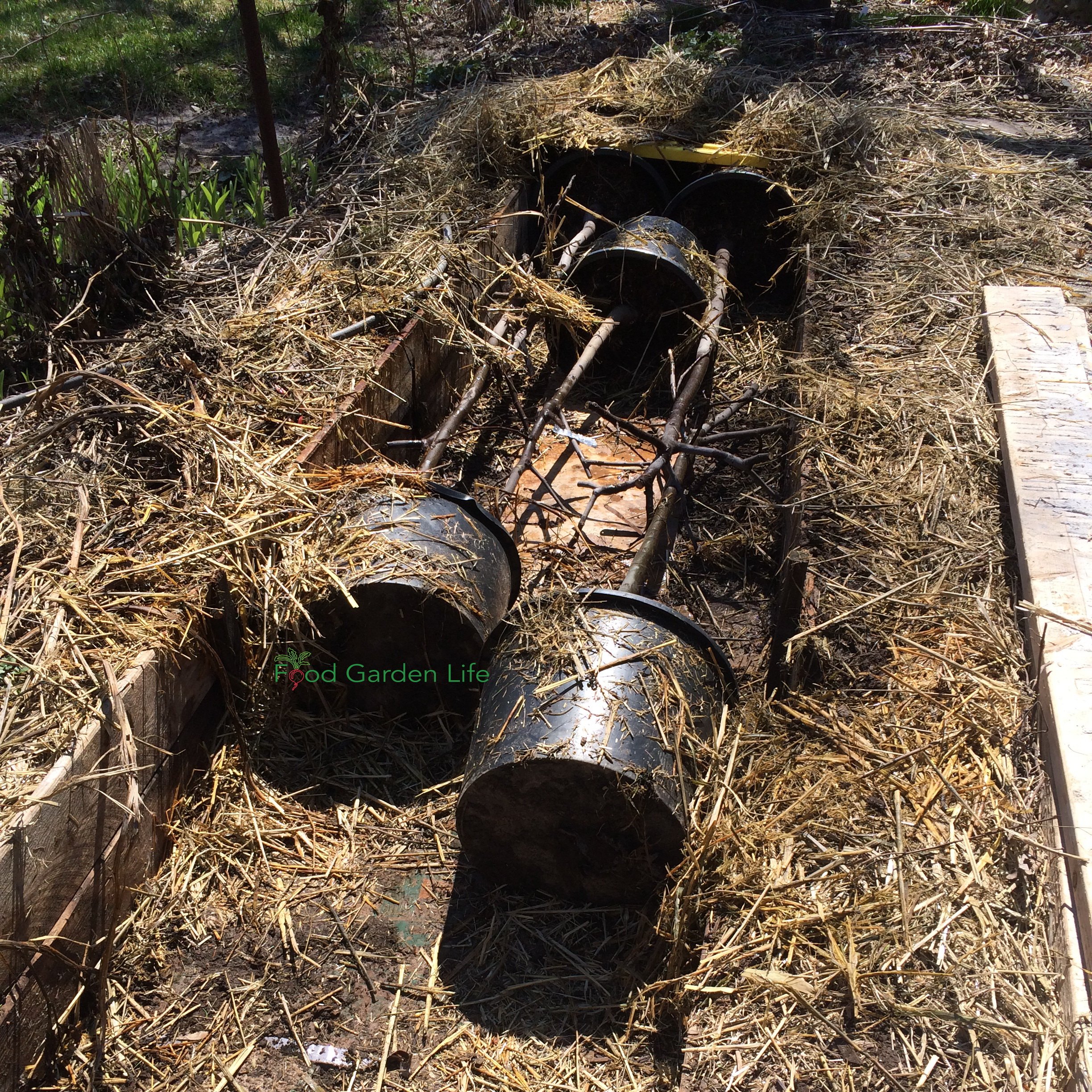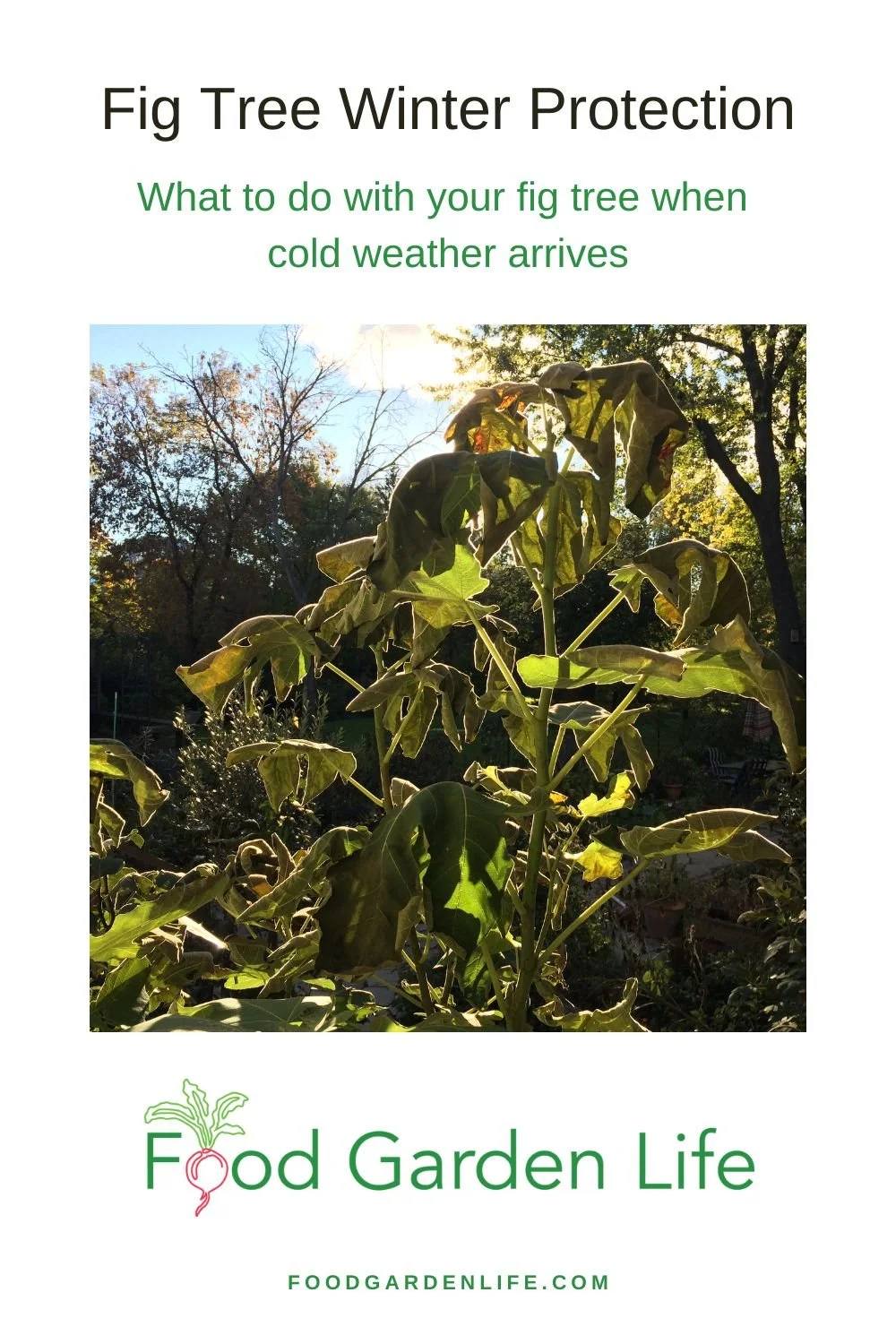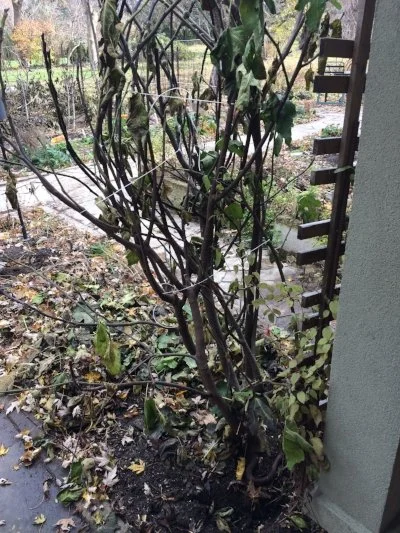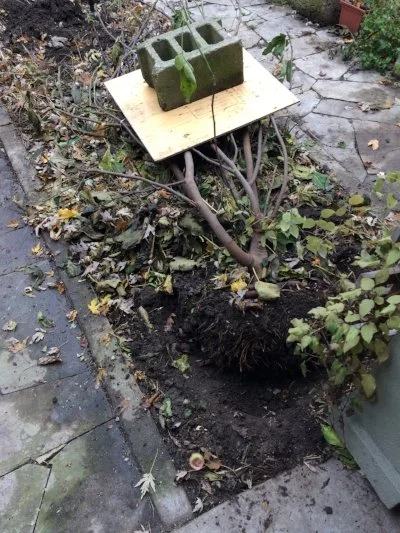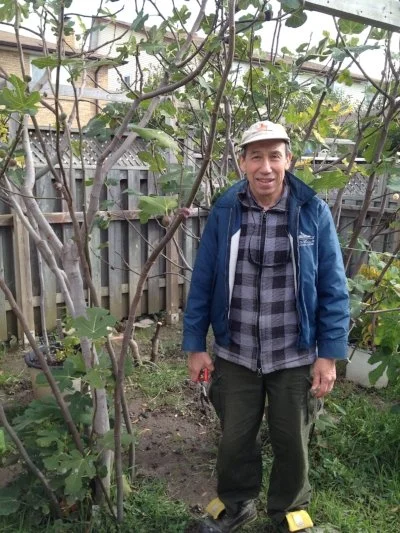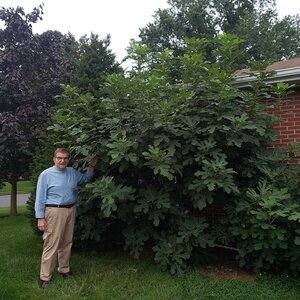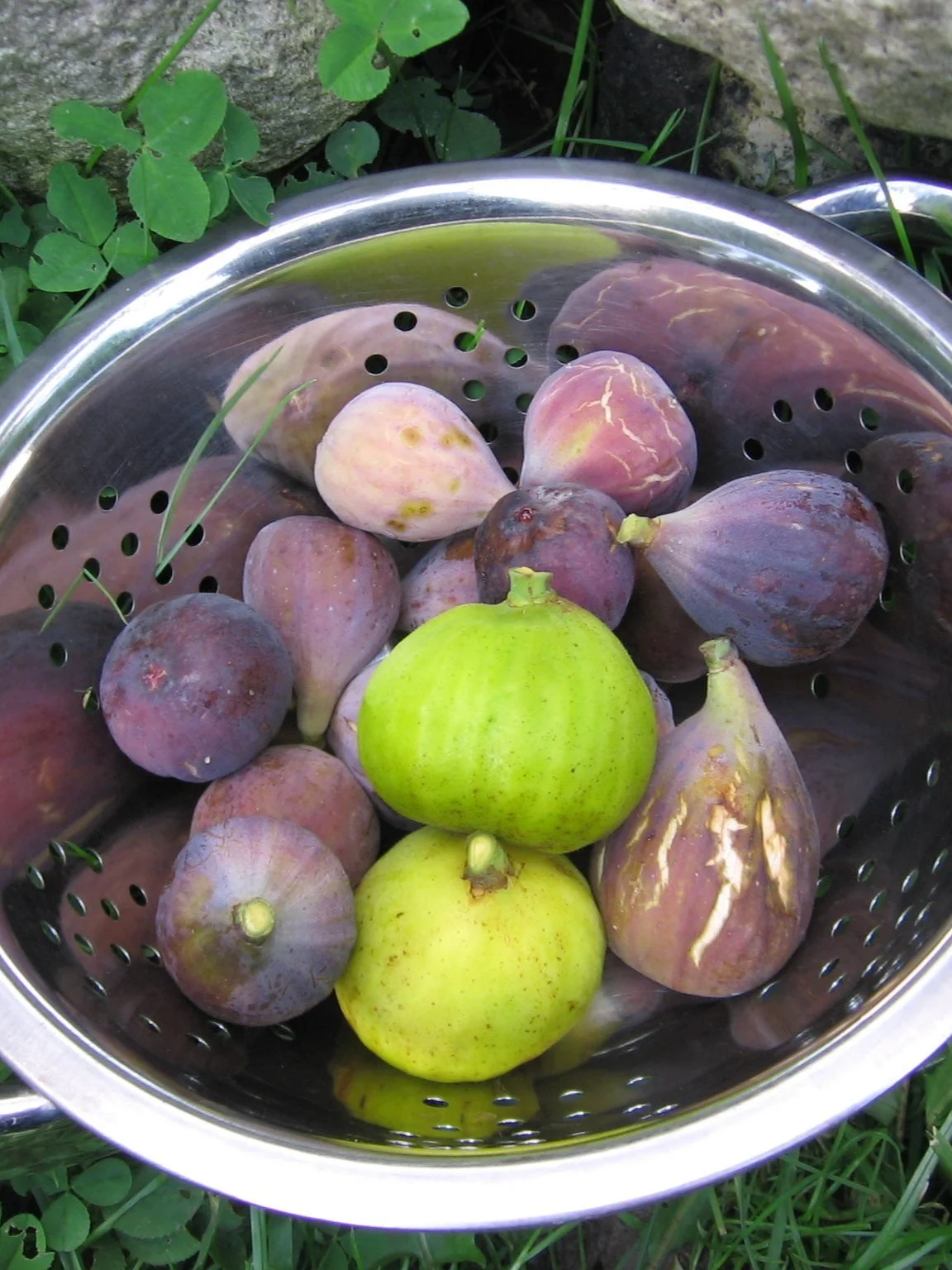These Espaliered Fig Trees Make Winter Protection Easy
Here's a way to grow figs that makes it easy to protect them for the winter in cold climates.
By Steven Biggs
Diminutive Fig Low Cordons for Easier Overwintering
Fig low-cordon espalier, an easier way to grow an in-ground fig tree in a cold climate.
Francesco had a fig tree in his Toronto yard. And every year, in what became a community event, he and some neighbours wrapped it up in burlap and tarps, then wrestled it down to a horizontal position, into a trough they’d dug for it. Then they covered it up for the winter. Each spring, they’d reverse the process.
When the tree got too tall to be tipped, they built a temporary enclosure around it, and put a space heater inside. It’s a fun story, and you can hear about it here.
It’s also heavy work. (I tip some of my fig trees, but I keep them much smaller than Francesco’s…so I don’t need to invite over the neighbourhood! See how I tip my fig trees.)
If tipping trees isn’t your cup of tea, there’s an easier way to grow an in-ground fig tree in a cold climate.
In this post I’ll tell you about growing a low-to-the-ground fig espalier that’s pruned right back in the fall.
No tipping. No wrapping. No lugging potted figs to a protected spot. Just cover the ground-level stem.
Keep reading and I’ll explain how to make yourself a simple-to-cover fig low-cordon espalier.
What is Espalier?
Espaliered pear trees at Mount Vernon.
Espalier is when we prune a tree so that it’s flat: It’s a two-dimensional tree.
In borderline fruit-growing areas such as northern Europe, there’s a long history of growing espaliered fruit trees against stone and brick walls. The walls warm up in the sun, and the flat fruit tree is nestled up against the warmed walls. The extra little bit of heat protects flowers from frost damage and speeds up ripening.
Along with extra heat, espalier is also a great technique to fit fruit trees into small spaces. I grow espaliered apples along a fence where there’s not enough space for a wider tree.
While espalier can be practical, it’s also be an art form. At Mount Vernon, George Washington’s estate (open to the public and well worth a visit) there are espaliered pear trees that frame the plots in the kitchen garden.
A Belgian fence is like a living wall!
Another beautiful espalier is the Belgian fence. A Belgian fence is like a living wall, with trees pruned to grow in a lattice-like pattern. (There’s are nice examples at Royal Botanical Gardens in Hamilton, Ontario, made from crab apple and serviceberry.)
There are many other espalier forms worth investigating if you like making the garden an artistic creation as well as a food-bearing one. Here are three of them:
Candelabra: U-shaped main stems that reach out horizontally, before bending upwards
Fans: As the name says, fan shaped
Step-over: A very low, horizontal main stem (called a “cordon”) that is close to the ground. (There’s a famed step-over apple tree in Monet’s garden…I’ve never seen it, but have seen pictures of it.)
Today, we’re taking our inspiration from Monet’s step-over apple tree. We’re using the step-over form—low cordons—to make overwintering fig trees in cold climates easier. I wonder what Francesco would think!
Get Your Fig Trees Through Winter
And eat fresh homegrown figs!
What’s a Fig Tree Espalier?
Before we unpack the idea of the fig low cordon, let’s quickly look at other forms of fig espalier.
It’s rare to find large fig trees for sale here in Toronto. Rarer still are unusual varieties. I never see fig espaliers.
Espaliered fig tree in a pot. This one was rather dear…so I made my own instead!
Except once I did.
One day I came across a fig espalier at a nearby garden centre. As soon as I saw it, I pictured this potted fig espalier on my driveway, flat against my house. It was a bit of a tangled mess—but nothing a good pruning couldn’t fix.
Then I flipped over the tag to see the price. Gulp. $500.
So that fig espalier never made it home to my driveway.
Instead, I went home and looked through my potted figs to see if I had any with branching suited to creating an espalier. I did, and you can see the beginnings of my work in the picture below.
In a climate such as mine in Toronto, potted fig espaliers like this have a couple of benefits:
They look nice (imagine a patio surrounded by a living wall of figs)
Placed against a warm, south-facing wall, there is lots of heat to ripen the figs faster
Pruning fig trees to make an espalier is something a home gardener can tackle. Here’s a fig espalier in the making.
But I think the form of espalier that has the most to offer cold-climate growers in areas such as my Canadian Plant Hardiness Zone 6 (USDA Zone 5) garden is the fig low cordon, a.k.a. the step-over fig.
The Fig Low Cordon Espalier
Like the other espalier forms, with a fig cordon we’re making a “flat” tree. But the main stem is horizontal—and it’s just above the ground level.
Think of those pear trees from George Washington’s garden. Now, imagine them hugging ground level.
Benefits of a Low Fig Tree Over Cold Winters
This step-over form makes overwintering of in-ground figs trees very easy. There’s no wrapping. No space heaters. No tipping.
It’s easy to prune. Before winter, all new growth is removed. It’s that straightforward.
That seemingly harsh pruning means that all that has to be protected for the winter is the horizontal cordon—and it’s so close to the ground that it’s a cinch. (We’ll talk about protection below.)
There’s something else we should touch on too: Why this drastic pruning method works with figs. It works because figs can form on new wood. (With many fruit trees, it’s the older wood that bears flowers and fruit.)
Note: this method won’t grow you any breba figs…none! Breba figs form on wood from the previous year—while main-crop figs grow on new wood. With the low-cordon espalier fig, all the fruiting wood each year is new wood, meaning all the figs are main-crop figs.
Where to Grow a Fig Low-Cordon Espalier
Location is very important. The first time I tried fig cordons, I planted them in a low-lying part of my property where the soil was slow to heat up in the spring. The fig trees survived, no problem. But because they were slow to wake up in the cooler location, the season wasn’t long enough for figs to ripen.
Here's what I recommend:
Full sun
South-facing, so the soil heats up
Even better if it’s beside a wall for extra heat capture
How to Make a Low Fig Cordon Espalier
Fig low cordon that I made by lopping the top off of a mature fig trees, and them planting them so the trunk was almost horizontal, right above ground level.
The first time I made fig cordons I cheated. Instead of developing new branches, and training them horizontally, I took fig trees with long, straight trunks and planted them so that the trunks were almost horizontal. So if you want an instant step-over, low-cordon fig, that’s what I did.
But here’s a more traditional approach, starting with a small fig tree.
Year 1: In the first year, you create the cordons
Year 2: Then, the following year, you allow upright growth (and figs!) to form
Year 1, Scenario 1
Fig tree has a few branches coming from the base
The goal in year 1 is to create the cordon, the low, horizontal branch that’s just above ground level. This is an example of a cordon.
If you have more than one branch, keep the two tallest branches (so you can have cordons going out in both directions from the base)
I grow branches at 45 degrees for the first year because they grow more quickly than if they’re horizontal. Tie them to bamboo stakes that are on 45° angle
At the end of the first year, gently bend over the 2 branches so that they’re horizontal
You will probably need to pin down the “cordon” at first (I use a wire hoop, see Hints and Tips below)
The bamboo on the cordon is temporary, remove it after a year, once the cordon has thickened and stays in place
Year 1, Scenario 2
Fig tree has only one branch
Pinning down the cordon after bending it to a horizontal position, using metal wire hoops.
If your fig tree has only one stem, decide if you want a cordon on just one side—or if you want cordons on each side
If you want a cordon on only one side, train the single stem as above
If you want 2 cordons, nip off the top of the stem at the height where you want cordons (this causes new shoots to grow)
Keep two new shoots for cordons—and treat as above
Year 2
In year two, with the horizontal cordons in place, upright shoots to grow.
Pruning an Established Low-Cordon Fig Espalier
Spring Pruning
Fig cordons at Fruit Trees and More. Not the spacing and bamboo stakes. (These figs are in a moderate climate where winter protection is not needed—but this is a good method to grow figs in a small space and make them easy to harvest.
The fig tree might try to make more shoots than you need. Prune so they’re spaced 15-20 cm (6-8”) apart.
To grow them straight upwards, tie them to bamboo poles.
Fall Pruning
As the fig trees go dormant in the fall, cut back the vertical branches to within an inch of the cordon.
Leave a nub of branch, about 2 cm (1”). It’s from this that new branches arise in the spring.
If the ends of the cordons grew out over the summer, now is the time to shorten them back to your permanent framework.
Protecting a Fig Low-Cordon Espalier for the Winter
With the vertical branches removed, you’re left with only the cordon. And it’s just above the ground.
All you need to do is insulate it. Because it’s low to the ground and insulated, winter temperatures are moderated and stable.
The colder your winters, the more insulation you’ll need.
Here in Toronto, it’s enough for me to insulate with straw.
(I use straw for straw-bale gardening. Find out how to make a straw-bale garden.) If you don’t have straw, here are other ideas:
Bags of potting soil
Garbage bags filled with leaves (preferable to raking leaves over top because wet, matted leaves don’t insulate as well as dry leaves with air.)
Espalier Fig Spacing
You have a lot of leeway when choosing the spacing for your fig cordons. If you want longer cordons, obviously you’ll need fewer fig trees. If, like me, you have lots of fig varieties to fit into a small garden, you might opt for shorter cordons and more fig trees!
The tip of a cordon can reach it’s neighbour. No need to leave much of a gap in between.
Variations
Fig Trench
I also grow fig cordons in a trench. The idea of a trench is that it stays a bit warmer over the winter. In late fall, I cover the top of the trench with windows and bags of leaves. In spring, once I remove the bags of leaves, sun shines through the windows into the trench to warm things up.
The colder your zone, the more appealing a trench might make.
(There’s a rich history of trench cultivation! Here’s a fun article if you like this idea.)
Fig Trees in an X-Shape
Don’t be constrained by the 2-dimensional nature of espalier. You could make a low-to-the-ground fig growing out in an X pattern.
Early spring start
In cold climates, summer heat and season length are limiting factors to ripening fruit. If fig plants wake up in good time, the season is longer. Then there’s more chance of ripe figs.
Warm soil helps to wake up the fig tree. A south-facing location warms up more quickly than a location with less sun. If the location is next to a wall or something that catches the heat from the sun, the soil warms more quickly.
I have a low stone wall next to my cordon fig trees to capture heat. In the spring, I angle old windows against the wall, making a temporary low-tech mini greenhouse. The windows hold in heat to help the fig trees wake up earlier. They also protect them from late spring frosts.
Low stone wall next to cordon fig trees.
Fig Varieties for Fig Espalier
Choosing the right fig variety is important for success with fig cordons in cold climates.
Here’s what we’re looking for a fig variety suited to low-cordon espalier:
A consistently heavy main crop
An early-ripening main crop
Tolerance of harsh pruning (my ‘Ronde de Bordeaux’ was not pleased about it)
I’m still experimenting with this, but my best results have been with the variety Natalina. Tune in to my chat with Jonathan Bates, below, to hear what he does with cordon figs. He has good results with the varieties ‘Florea’ and ‘St. Rita.’
(If you’re using this method and have a variety that does well, e-mail me—I’d love to hear about it.)
Hints and Tips
While you’re first forming the horizontal cordons, tie them to horizontal stakes so that they’re straight. I use bamboo stakes and sisal twine, which decomposes within a year.
If fig trees are growing quickly, the tie might constrict the branch—so check a couple of times over the summer to make sure the branch hasn’t outgrown the tie.
To pin down the cordon until it’s thickened and stays in place, use metal hoops. I make them from 14-gauge galvanized wire, the same wire that I used to create a framework for my espalier apples. Pieces of metal coat hanger work nicely too.
FAQ Fig Tree Espalier
Pin this post!
I accidentally broke a branch I was trying to bend. What should I do?
All art is recovery from the first stroke. And with pruning, we recover by encouraging and training new growth to do what we want. Be patient, and the fig will send out a replacement shoot that you can train to go where you want it to.
(one year the squirrels chewed off ALL the branches on my new apple espalier. I was furious! But the tree sent out new branches, and now you wouldn’t even know!)
Can I prune my fig tree even more, right back to the roots, so it's even more easy to cover for the winter?
That would sure make overwintering easy. That harsh a pruning is too much of a setback for a cold-climate fig tree. There probably won’t be enough time in a short season for new branches to ripen figs. (There will be new growth, and it will have figs…but they probably won’t ripen in a cold climate.) Retaining that horizontal fig cordon through winter means the pruning isn’t so much of a setback—and the new growth it sends out will produce figs that ripen.
Hear a Chat with a Greenhouse Grow who has Fig Cordons
Tune in to this chat with Jonathan Bates at Food Forest Farm in New York State. To grow figs in his cold growing zone, near the finger lakes, Bates grows horizontal cordons low to the ground, within a greenhouse.
Find This Helpful?
If we’ve helped in your food-gardening journey, we’re always glad of support. You can high-five us below! Any amount welcome!
This is the Biggs-on-Figs segment from the Food Garden Life Radio Show that broadcast in February 2021.
More on How to Grow Figs
More Fig Articles
Head back to the fig home page to search for fig articles by topic.
Fig Books
Fig Course
Fig Masterclass
The self-paced online fig masterclass gives you everything you need to know to grow and harvest your own figs in a cold climate!
(We also run it live once a year. If you’re interested in knowing when we next run the live online fig “camp” I’ll announce it in my newsletter. Hop on the newsletter list here.)
Potted Figs Waking up Early? Here’s Why, and What You Can Do
Your potted figs are leafing out early... When fig trees come out of dormancy early, you need to know what to do next so that you can still harvest figs. Find out what to do—and how to avoid figs waking up early next year.
By Steven Biggs
How to Prevent Dormant Potted Fig Trees Leafing Out Early
“HELP…my fig tree is growing already!”
I often see this sort of e-mail subject line in my inbox in late winter. If your dormant fig trees are sprouting too early, you’re not alone.
Dormant fig trees are easy to care for. But when conditions aren’t right, they come out of dormancy early and start growing sooner than you want!
And when they start growing early, in dim light, you get lanky growth and fruit that might not make it to maturity.
Keep reading. This post will help you decide what to do if your fig tree is leafing out early.
The Problem When Your Fig Tree is Awake Early
Fig tree leafing out early, in a crawl space with no light. Notice the lank, yellow growth.
In cold climates, where fig trees are not hardy, we can store them as dormant trees over the winter.
But if the fig trees wake up early, it can affect your fig harvest!
Growing figs indoors over the winter as houseplants isn’t likely to give you a good harvest.
The low-light conditions indoors over winter gives lanky, weak branches—and that can affect your harvest once you move the fig outdoors for summer.
Why Fig Trees Wake up Early
When potted dormant fig trees leaf out early, it’s usually because the storage area is too warm.
Basements in modern, centrally heated homes usually are not cold enough to keep a fig tree dormant all winter.
It really depends on your house, though:
A friend had a century-old farmhouse with an uninsulated, unheated, earth-floored basement…fantastic for dormant figs. That’s the kind of space that keeps fig trees dormant.
My garage is unheated and is a perfect spot for overwintering dormant figs.
Some modern homes have a good root cellar—and the desirable temperatures for root cellaring also work well for keeping fig trees dormant.
A Note on Dormancy
There are a few things that work together to induce and keep a fig tree in a dormant state:
Heat
Day length
Soil moisture
But I’ve found that the single most important thing to focus on to keep your fig tree from leafing out early is temperature.
Yes, longer days plays a role in figs waking up. Having said that, when I store dormant potted fig trees in my garage—which has windows—they don’t wake up too early. That’s because it stays consistently cool.
What to Do if Fig Trees Start Growing Early
What do you do if your fig tree is awake early?
Here in USDA Zone 5, if figs wake up mid- to late-winter, it’s just too cold to put them outside to coax them back into dormancy.
The tender growth they’ve made inside is quickly zapped by the cold.
So let the fig tree grow indoors—but give it the most light possible.
Here’s a guide about what to do with fig trees in the spring.
Let’s dig into a couple of examples of potted figs sprouting so that you can think about what you could do if your figs leaf out early.
Get Your Fig Trees Through Winter
And eat fresh homegrown figs!
It’s dark, but it’s also too warm…so the fig trees have started to leaf out early!
EXAMPLE 1: Figs Leafing Out Early
Here’s an example of a late-winter note that I received about potted figs sprouting early. Holly wrote:
I brought my six fig trees inside and put them in my crawl space. They are in large containers with reservoirs in the bottom.
Anyway, it is dark but too warm, and they are spouting small albino-pale leaves.
Now I don’t know what to do? Leave them? Move them to my cooler sunroom with light? Help!!!
Here is my response:
Sorry to hear about your fig dilemma! Yes, it looks as if it is too warm, so they’ve come out of dormancy early. It's hard to get trees back into dormancy. If you put them in a cool sunroom with bright light that would be the best choice—as long as they don’t freeze.
The Challenge
Even though it’s completely dark, it’s too warm in Holly’s crawlspace.
If fig trees come out of dormancy early, give them light—otherwise the growth is lanky like this.
So the fig trees started to grow.
What to Do
Find a bright indoor space to grow the fig trees until they can go outdoors for the summer. The brighter the better—so they have compact growth. But they mustn’t freeze now that they are growing.
(A dormant fig tree can freeze. Find out how cold fig trees can get.)
Holly has a sunroom, and that’s the best option in this case. In fact, it’s a very good option, because it bright and cool.
Other places you can put fig trees that come out of dormancy early:
In front of a bright south-facing window
Under artificial lights (less than ideal…but if it’s all you can do, it’s better than nothing)
Avoid Early Sprouting Next Year
Holly told me next year she might build an insulated space within her garage so that her figs don’t leaf out early. This insulated storage space is a really practical approach for garages that get too cold for potted fig trees to survive.
(Even garages that are warm enough for dormant figs can get too cold when the large doors are opened in winter.)
To make this sort of insulated storage space, build a lean-to or closet inside the garage, against the outside wall of the house. This gives a protected area where the temperature does not fluctuate as much when the garage door is open.
EXAMPLE 2: Figs Leafing Out Early
Here’s another example of a late-winter enquiry I received about potted figs coming out of dormancy early:
“My fig trees are growing, what should I do?”
“My fig trees are growing, what should I do?” David’s fig trees awake early…
That was the start of a late-March phone chat with my neighbour David. A fellow fig enthusiast, David grows his figs in pots on his patio over the summer. He leaves them out in the fall until they’re dormant.
The potted fig trees spend the winter in his garage.
The garage is heated because David works out there on his cars over the winter. And it has lots of big windows. The combination of light and temperature were enough to coax the fig trees out of dormancy earlier than David wanted.
The Challenge
It’s still too cold outside to put the potted fig trees outside in bright light. There will be more freezes, and that would kill the tender new growth.
But the light in the garage isn’t bright enough for good compact growth.
What to Do
There’s no putting these impatient fig trees back into dormancy.
And it would be a terrible shame to trim them back and lose the breba fruit.
Lots of Lights
I suggested to David that he put the fig trees in the brightest spot in the garage that he can until it’s a bit warmer. Then he can move the figs out on warmer days, so they’re in brighter light. (Starting in a sheltered, shaded spot so they are not scalded by the bright sun or get wind burn)
The other idea I mentioned to David is a simple, temporary greenhouse built against his garage. Like a temporary greenhouse just for his figs in this shoulder season.
Figs awake early… David’s potted fig trees are sprouting in his garage, and making lanky growth.
Avoid Figs Waking Up Early Next Year
Next year, there are a few things David can try so that he doesn’t have the problem of fig trees waking up early.
Keep the garage cooler
Or, instead of making the whole garage cooler and darker, wall off a corner—like a mini cold cupboard—for his figs
Overwinter the figs outdoors (plant in the ground and tip over and mulch for winter; or, use the trench method for potted figs overwintered outdoors)
Here are more ideas for overwintering figs in cold climates.
Important Tip for Figs Trees That Leaf Out Early
Pin this post!
There’s one more thing to remember—and this is important.
When it's time to move the fig plants outdoors in the spring, put them in a shaded location to start with.
When fig plants have leafed out early indoors, in dim light, and you put them outdoors in bright sunlight, there is a chance of sun scald.
I’ve fried my fig plants many times when I’ve moved them into full sun too quickly.
Put the fig trees somewhere shaded for a few days before moving them to a sunny location.
Find out what to do with your fig tree in the spring.
FAQ – Figs Waking up Early
Why does my fig wake up early?
The most common reason is that it’s too warm.
So should I grow my fig indoors now that it’s awake?
It’s not ideal to grow your fig as a houseplant. You’ll get lanky, weak growth. But if it’s too cold outside, grow it indoors—and then give it conditions to keep it dormant all winter next year.
Do fig trees need light to wake up?
Nope! As Holly’s predicament, in Example 1 shows. Light is involved in dormancy…but heat is the thing to pay the most attention to when you want to keep your fig tree dormant.
Do figs lose their leaves over the winter?
In cold climates fig trees drop their leaves and go dormant for the winter. This is great for cold-climate gardeners because it gives us lots of ways to safely store fig trees in a protected space. (In tropical climates they can grow all year long…not a situation that I have here in my USDA Zone 5!)
How do I get my fig to go dormant?
Shorter days and cold temperatures cause your fig to go dormant. Leave your potted fig outdoors through the first fall frosts to help it go dormant. If you take your fig indoors before it’s dormant, it might not go dormant.
More on How to Grow Figs
More Fig Articles
Head back to the fig home page to search for fig articles by topic.
Fig Books
Fig Masterclass
The self-paced online fig masterclass gives you everything you need to know to grow and harvest your own figs in a cold climate!
Watering Dormant Potted Figs...and Getting it Right so They Survive Winter
Pointers on how often to water potted dormant figs over the winter.
By Steven Biggs
How Often to Water Dormant Figs
Once you protect your dormant, in-ground fig plants for the winter, there’s no need to think about watering them over the winter.
In the same way that you don’t need to water dormant landscape shrubs over the winter, you don’t need to water your dormant, in-ground fig trees.
But your potted fig plants might need water.
Or they might not.
It depends on the conditions where you’re storing them.
This post will help you figure out how often to water a dormant fig plant.
Don't Overwater…
When a dormant fig plant gets too much water, the roots might rot.
Knowing when —and whether — to water can be difficult to gauge for new growers.
Here’s how I judge: I stick my finger right into the soil—and if I feel moisture, I don’t water.
Explained another way: Keep the soil on the dry side of moist.
Not Too Dry Either…
Not sure how often to water dormant fig trees? Keep them on the dry side of moist.
But if the soil becomes too dry while the fig plant is dormant, the plant can die.
If the soil feels extremely dry, it’s probably time to water.
Remember: Keep it on the dry side of moist—not bone dry.
You will know the soil is quite dry if it shrinks and is no longer in contact with the edge of the pot.
When potting soil shrinks like this, water goes down the side of the pot instead of soaking into the soil. So before watering, use your fingers to spread out the soil so there is no space for the water to go down the side of the pot.
Is There a Rule for How Often to Water?
No.
When dormant figs are stored somewhere with dry air (e.g. in a cold room in house with forced air heating) they might need occasional watering.
But they might not.
The figs in my garage, where the air is humid, often need no water all winter long.
Fig Trees Waking up Early?
More on How to Grow Figs
More Fig Articles
Head back to the fig home page to search for fig articles by topic.
Fig Books
Fig Masterclass
The self-paced online fig masterclass gives you everything you need to know to grow and harvest your own figs in a cold climate!
Figs and Winter Temperatures
Find out what you need to know about fig hardiness and winter temperatures so you can figure out what sort of winter protection (if any) your fig trees need.
What’s the Hardiness of a Fig Tree in Winter?
Fig plants tolerate more cold than many people realize.
But just how cold can they get without damage?
It depends on a few different things.
This article tells you what you need to know about fig hardiness and winter temperatures so you can figure out what sort of winter protection (if any) your fig trees need.
(If you already have an idea of how hardy fig trees are in your area and just want ideas to get them through the winter, find out more here.)
Hardiness Isn’t Exact
Hardiness is never an exact thing.
That's because fig tree hardiness is affected by what's going on with the tree—and it's also affected by the conditions around the fig tree.
The cold hardiness of fig trees is affected by what's going on with the tree:
Young trees are more tender than mature trees
Fruit and new growth are affected by cold before older, woodier stems
If the fig tree is dormant, it can better withstand cold
Some fig varieties are more cold-tolerant than others
The conditions the fig tree is exposed to also affect cold hardiness:
The duration of cold temperatures
How sheltered or exposed the fig tree is
How many degrees the temperature drops
The timing of extreme cold (e.g., at the end of the night the plant might be soon warmed by sun)
Get Your Fig Trees Through Winter
And eat fresh homegrown figs!
So How Much Cold Can Fig Trees Take?
There is no magical number. Some fig plants can take temperatures as cold as -7 to -9°C (15-20°F).
Some colder.
Some not so cold…
If you want to think in terms of zones, you’ll often see the recommendation that figs are hardy into USDA Zone 8. But you can push the growing zone recommendations if you figure out a way to moderate temperature extremes around your fig plant over the winter.
Even if a cold winter causes the top of a fig tree to die back, the roots usually survive and send up new shoots.
Potted Figs: Remember the Root Ball
If you're growing fig trees in containers, it's good to remember that a potted fig tree can't tolerate as much cold as an in-ground fig tree.
That's because the root ball will freeze and thaw more often and more quickly than the soil in the ground.
The main trunk and branches probably have the same cold tolerance.
Things to Think About as you Plan Fig Tree Winter Protection
Here are things to think about as you consider what to do with your fig tree for the winter.
Your Zone: How much protection your fig tree needs over winter is affected by your plant hardiness zone.
Microclimate: Most gardens have some sort of protected area (called a “microclimate.”)
Your Storage Options: Each house and yard is different. I met a Toronto gardener with what he called a “fig cave”. This cave—and underground stairwell between his garage and his house—was a sheltered space he used to store dormant potted fig trees. In some areas, you might not need to store potted figs—and might only need to wrap in-ground fig trees during winter months.
Your Budget: There are lots of gadgets… I’ve met gardeners with thermostatically controlled space heaters. Other gardeners keep things simple, using insulating materials.
You: The way that you decide to protect your fig over the winter will depend on how much lifting and hauling you want to deal with.
Get ideas to overwinter figs in cold climates.
Find out about fig varieties suited to cold winters.
FAQ: Winter Fig Tree Hardiness
Do figs lose their leaves in winter?
Yes.
How do you take care of a fig tree indoors in the winter?
In a cold climate, it's easiest to let a potted fig tree go dormant, and then store it somewhere cool and dark for the winter. Find out more ways to overwinter figs in cold climates.
Do figs do well in pots?
The do very well in pots. Here's an article that gives more information about how fig trees grow.
Where is the best place to keep a fig tree in the winter?
There is no best place. It depends on how cold your zone is and what sort of spaces you have for winter protection.
Should I prune my fig before I store it for the winter?
It depends on a few things. Find out more in this Cold-Climate Guide to How to Prune a Fig Tree.
More About Fig Trees in Cold Climates
Find out how to protect a fig tree for the winter.
Find out more about how to grow fig trees in cold climates.
Here are fig varieties that cold-climate fig growers recommend.
Books on Fig Trees
Courses
What to do with a Fig Tree in Winter
Find out what you can do to protect a fig tree in winter. There are lots of ways to do it, and the right choice will depend on your situation.
Fig Tree Winter Protection
In places where the seasons change, figs drop their leaves and go dormant over the winter.
In some places, you don’t need to do anything for fig trees to survive the winter.
But as you move into colder zones, you’ll need to protect a fig tree in winter.
Protecting a fig tree in winter is fairly easy because the tree is dormant. There are no leaves, and you don’t have to fuss over it.
A dormant fig tree is easier to take care of than a houseplant!
This guide to how to protect a fig tree in winter has lots of ideas for ways to protect your fig plants.
You Don’t Need a Greenhouse for Fig Tree Winter Protection
I break fig tree winter protection into two broad tactics:
Indoors
Outdoors
Remember, they go dormant. If they haven’t already shed their leaves by the first fall frost, they will drop them soon afterwards.
Having no leaves means you don’t need bright conditions for them. They don’t need warmth either.
Fig Tree Winter Temperatures
Fig leaves wilting after frost. As the fig tree goes dormant, you have many options for protecting it over the winter.
Fig trees can take colder temperatures than many people realize. Mature trees survive temperatures down to approximately -7 to -9°C (15-20°F). (Often more…but hardiness is not an exact science.)
Figs are hardy into USDA Zone 8. And beyond that with suitable varieties and the right location.
Here’s your challenge: Figure out a way to moderate temperature extremes around your fig plant over the winter.
If you’re new to figs, read this introduction to figs.
Whichever way you protect your fig tree for the winter, you’ll want to keep the plant dormant until you’re ready for it to grow in the spring. So ideally, you want somewhere cool and dark.
If it grows indoors, in low-light conditions, you end up with weak, lanky growth. Here’s what you’d end up with.
Fig Tree Winter Protection – Winter Outdoors
Outdoors – Tipped Over
A common overwintering technique in cold climates is to lay over the fig plant so that it’s at ground level. This is because soil temperature fluctuates more slowly than air temperature – and the soil temperature usually doesn’t get as cold as air temperature.
In very cold areas, fig growers will lay over a fig tree and bury it below the ground level. Being below ground level and covered with soil greatly moderates temperature changes.
In areas where winter temperatures are not as cold, it might be sufficient simply to lay a fig plant flat to the ground and then mulch it.
In either case, it is helpful to prune the plant first, and then tie the branches together before laying it flat. It makes it easier to cover.
One final consideration: Mulches that are dry have better insulating properties.
Steps to Tipping Over Fig Trees for Winter
Prune your dormant fig tree.
Bunch up the branches with twine…it might look like a rocket ship!
Excavate around the tree (leaving just a little “hinge” of roots on the side towards which it will be tipped).
Bend, and see if it moves. If not, dig more. Don’t force so hard that you break the trunk…I know from experience that this can happen.
When you’ve finished digging, there will be far fewer roots…and that’s OK.
Tip over the plant so that it’s flat to the ground.
You might find it necessary to pin down the plant (I use concrete blocks over a piece of plywood).
Cover with mulch or soil (if using soil, you can put down a plywood covering first, which makes it easier to unbury the plant in the spring).
Get Your Fig Trees Through Winter
And eat fresh homegrown figs!
Materials for Insulating Fig Trees for Winter
There are lots of materials that can be used to insulate figs. I use straw bales (which I use for my straw-bale gardens afterwards.)
Here are some more ideas:
Bags of potting soil
Leaves in garbage bags
Wood chips
Wood with foam sheeting attached
Some gardeners also use a tarp or sheeting so mulch doesn’t get wet and lose insulating properties…just be aware that tarps can hold in moisture, and a wet tarp touching shoots can cause rot
Outdoors – Wrapping a Fig Tree for Winter
Fig tree wrapped for winter. (Spoiler alert, there is a heat tube hidden in there, here’s how it’s done.)
In some areas, it’s possible to leave in-ground fig plants in the same spot year-round, without chopping away at the roots and tipping them flat to the ground.
In such borderline hardiness areas, gardeners can simply wrap fig trees to protect them.
Wrapping materials can include:
Burlap (topped with tar paper so water does not seep in)
Old carpet
Snow fencing and filled with dry leaves
Where wrapping is not quite enough, a temporary structure can provide sufficient protection.
Temporary structure ideas:
A fig bush bent over for winter, and covered with an insulated a-frame.
Building a box-like structure against the wall of a building to shelter figs growing against the wall
A “fig house” made by cladding plywood to posts
An insulated a-frame structure built over bent-over fig plants
In any of these temporary structures, a drum full of water can be used to capture and slowly release heat.
Here’s a super-creative temporary structure, heat tubes!
Fig Tree Winter Protection – Winter Indoors
Indoors – In a Bright Space
Dormant fig trees spending the winter in my cold, bright potting shed.
If you have a greenhouse, you can keep your fig there. Let your potted fig become dormant, and then store it in the greenhouse. The temperature can be cool in the greenhouse – you don’t need to keep the fig plant actively growing.
Some gardeners have a small greenhouse that is only heated in time to grow seeds for spring garden transplants. This sort of setup can work well, waking up your fig early so that it has an early start. The key thing to watch is the minimum temperature in the early winter, when the greenhouse is unheated.
If you’re considering planting a fig in the ground in a greenhouse, know that they grow a lot. It’s common practice to line the bottom and sides of the planting hole with stones or brick to restrict root growth.
One final thought on figs in greenhouses: A greenhouse that has permanent sides and a removable top. I saw this setup once, something that the owner, Peter, called his “figatorium.” Same idea as a sports stadium with a retractable roof!
The advantage to this sort of arrangement is that the plants benefit from more warmth in the shoulder seasons of spring and fall, allowing an earlier start and additional ripening time in the fall. In areas with sufficient summer heat for ripening main crop figs, the removable roof is helpful because it prevents the temperature from becoming excessively hot.
Indoors – In a Dark Space
Dormant fig trees spending the winter in my cold, dark garage.
While many gardeners aspire to a greenhouse, a far more common approach to overwintering dormant fig plants is somewhere cool and dark.
I’m talking about somewhere like a cold cellar, a shed, a garage, or an attic.
Ideally, this space will have a maximum temperature of 4-7°C (40-45°F). If it’s warmer than this, fig plants often come out of dormancy earlier than you want.
If you have an indoor space but it gets too cold, consider an insulated space within it and heat only that space, and only as needed.
For example, build an insulated lean-to within a garage, or wrap plants with insulation.
A note on garages: Attached garages tend to be warmer than stand-alone garages, because they benefit from heat escape from the house. Structures on concrete pads tend to stay warmer too. I have a stand-alone garage, so I insulated it and installed a small electric baseboard heater. Here in the Toronto area, there’s no need for me to turn on the heater for most of the winter, and I only turn it on low for a few of the coldest days in January and February.
Indoors – Care over Winter
Check the soil moisture of dormant potted fig trees that are stored indoors over the winter. It should be on the dry side of moist.
How often you need to water (if at all) depends on the humidity of the air where you’re storing it.
If the soil is too moist, the roots might rot.
If the soil is too dry, the plant can die.
When you’re in doubt about when to water, stick your finger into the soil. If it feels damp, wait a bit longer.
Here’s more about how often to water a potted fig tree over the winter.
Top Tip: Fig Tree Winter Protection
Be creative and overwinter your figs in a way that suits you and your yard. Because fig trees go dormant, there are lots of different ways we can get them through the winter.
There is no need for a greenhouse or bright window to keep figs in cold climates!
Fig Tree Winter Hardiness
Many things affect fig tree cold hardiness:
Young fig trees are more tender than mature ones
Fruit and young shoots are affected by cold before older, woodier stems
If the fig tree is already dormant, it can take more cold
Some fig varieties are more cold-tolerant than others (see this article for good cold-adapted varieties)
And then there’s the elements:
The amount of wind the fig tree is exposed to
The duration of cold temperatures
How sheltered or exposed the fig is
How many degrees the temperature drops
The timing of the cold temperature (e.g., at the end of the night the plant might be soon warmed by sun)
Get Your Fig Trees Through Winter
And eat fresh homegrown figs!
Planning What to do with you Fig Tree in Winter
So now you have more ideas about fig tree winter protection, you can think about your own situation.
Here are things to think about as you plan what to do with your fig tree:
Your zone: How much protection your fig tree needs over winter depends on your plant hardiness zone and on whether you have protected areas within your yard (called “microclimates.”)
You: The way that you decide to protect your fig over the winter will depend on how much lifting and schlepping you can deal with.
Your Property: Each house and yard is different. I once met a Toronto gardener with what he called a “fig cave,” a stairwell between his garage and his house, which was on a hill. Think about what options you have for overwintering figs around your property.
Your Budget: There are unusual gadgets for people who want to innovate when overwintering figs. (For example, I know a gardener with a thermostatically controlled outlet that runs the heating cable around his fig.) Other gardeners innovate using commonly available supplies.
More on How to Grow Figs
Fig Articles
Interviews with Fig Experts
Fig Books
Fig Masterclass
Get Your Fig Trees Through Winter
And eat fresh homegrown figs!
Fig Tree Winter Protection with Ross Raddi
Here’s a chat I had with PA fig expert Ross Raddi about figs in cold climates.
Here’s a chat I had with fig expert Ross Raddi about figs in cold climates.
Ross is an innovative fig grower in PA who shares his fig adventures on his YouTube channel and on his website.
We chat about:
How I got into growing figs in a cold climate
My fig mentor
Protecting fig trees for winter
More Fig Growing Information
Fig Site
Fig Books
Fig Masterclass
Get Your Fig Trees Through Winter
And eat fresh homegrown figs!
Tipping Over an In-Ground Fig Tree for Winter
Niagara fig grower shares his recipe for overwintering his fig tree in a cold climate.
Richard’s fig tree tucked in for winter.
By Steven Biggs
Find a Method That Suits You and Your Garden.
When teaching new gardeners, I often turn to the analogy of making tomato sauce: I know five neighbours with five different recipes. They are all good.
Overwintering fig trees in cold climates is like making tomato sauce: if you talk to five different growers, you will probably get five different fig-overwintering recipes.
After my latest newsletter, Richard, who gardens in Niagara, sent me the note below explaining his recipe for overwintering his fig tree. With his permission, I’m sharing it with you.
When it comes to overwintering your fig trees, be creative and find a system that works for you and your situation.
NOTE: I really like the way Richard uses ratchet straps to reduce the amount of work that he has to do. Mental note to self to do this next year. Thanks Richard!
Richard’s Overwintering Technique
This is my fourth year overwintering a fig tree in Niagara. This is a method I learned myself, when, after the first year, my tree "died".
Then in late spring, shoots sprung up from the root ball - and my fig tree was given a second chance in at life.
My fig tree is now three-and-half years old and twelve feet high! We usually get two to three dozen figs a year.
I overwinter my fig tree in the following manner:
Start of second week in November
Wrap a ratchet strap around the girth of the tree and tighten the branches together
Wrap the tightened tree configuration with burlap
Tie the burlap with twine
Secure another ratchet strap about two thirds up the tree
Pound a stake in the ground in front of the tree about 7/8 the height of the tree away
Lay a tarp on the ground in front of the fig tree. Tarp should be at least two feet longer than the height of the tree. (The tarp will cover the stake)
Cut a small slit in the tarp to expose the stake underneath the tarp
Take some twine and tie it off to the ratchet end of the strap, and the other end to the stake
Slowly ratchet the entire tree toward the tarp so that it is about eighteen - twenty four inches from the tarp
Cover the burlap-wrapped tree with a bale of straw
Wrap the sides of the tarp up around the straw and tree and secure with ratchet straps at third points along the tarp
Cover the wrapped tree with another tarp and stake the perimeter to the ground (but not forcing the tree any tighter to the ground than what it is already).
Heap the base of the tree with black bark mulch
End of first week in April
Remove the tarps and the straw. Leave the burlap wrapped around the fig tree
The tree will spring up but will still have a lean to it. Leave it covered with burlap for another week
After a week, remove the burlap and mulch from the base of the tree (end of second week in April)
The lean in the tree will not affect leaf or fig development - and after a month, the tree will straighten with warm sun
One Additional Thought…
Very high humidity and condensation can cause dormant fig plants to rot. For that reason, I usually advise people to use an insulating material that breathes — something like leaves or straw or soil.
In the method above, Richard uses tarps — which don’t breathe. But he also removes them early in spring to check on and air out the plants.
More Fig Information
Articles and Interviews
Fig Masterclass
Get Your Fig Trees Through Winter
And eat fresh homegrown figs!
Fig Books
Bury Fig Trees for Winter in Cold Climates
A common way to protect in-ground fig trees over the winter is to lay them flat to the ground, and then insulate them with mulch or soil.
Fig tree ready to protect for the winter. I use twine to pull in tie the branches together before laying the plant against the soil.
By Steven Biggs
IT’S MID NOVEMBER and my fig trees here in Toronto have dropped their leaves and gone dormant. I moved my potted fig fig trees into my garage (I keep the temperature in the garage near freezing over the winter.)
But like many fig growers in areas with cold winters, I still grow figs in the ground and give them extra winter protection.
A common way to give that protection is to insulate the tree by burying it.
Chop Roots on One Side
At this time of year, I use a spade to chop away the roots on one side of the fig plant—and then lay it flat against the ground.
How Deep?
Some people avoid the burying method of overwintering figs, worried about the work of digging.
Once, after I gave a talk about figs, an audience member came up to me to confide that he had tried burying his fig tree, but it was too much work to dig down six feet!
I reassured him that it’s not necessary to dig his fig plant a grave—that at the most he needed a shallow trench. Then I explained that around here, the fig plants are usually fine if you lay them flat against the surface of the soil and put a thick mulch on top. You don’t even need to dig a trench!
Fig tree with roots loosened on one side, tipped over to lie on the ground. The board and concrete block weigh it down. Next step is to add leaves or straw over top to insulate it.
Next, the Covering
You will see in the above photos one of my fig trees before and after. Once the roots on one side are loosened and I’ve tipped over the plant, I put a board and concrete block over the top to hold it in place. Soon, I’ll put a thick layer of straw or leaves over the top to insulate it. And when it snows, I’ll heap on some snow too.
Remember the Rodents
But I don’t rush the mulching…mice love to eat fig bark, and I want them to find a home elsewhere before I mulch my figs.
More Information on Figs and Winter
Figs on the Prairies
Getting creative when overwintering fig trees on the prairies, in Edmonton Alberta.
Overwintering figs in Edmonton
By Steven Biggs
Overwintering Figs in Edmonton
Over the past few years I’ve been in touch with Bernie, a fruit grower in Edmonton, Alberta, Canada. Bernie’s minimum winter temperature can dip to -40°C (-40°F)…so his figs need a bit of help making it through the winter.
Laying the plants flat to the ground and mulching, as I do here in Toronto, isn’t enough protection for his figs from winter temperatures.
Buried Fig Tree
Bernie sent me this photo. There’s a fig tree in there, even though you can’t see it!
The fig tree is buried in a trench alongside the foundation of his house. He covers the buried fig tree with a few bags of leaves—like a blanket to keep it even warmer. Once snow arrives, he covers it with snow for added insulation.
Why bury the fig tree beside the foundation of the house? The soil close to the foundation stays a bit warmer.
Bernie uses a max-min thermometer to track temperatures. Last winter, the soil temperature around his buried fig tree dropped to 2°C (36°F), while outside, the air temperature outside dropped as low as -36°C (-33°F).
Some Figs in the Garage Too
Bernie also has potted fig trees that he stores in the safety of his garage for the winter—a more common fig overwintering technique in his garden zone.
Video
Check out Bernie’s video below.
Protecting In-Ground Figs: Door Method
Old doors: a simple way to protect in-ground figs growing in cold climates.
By Steven Biggs
Grow Figs in Pots or in the Ground?
Alberto with one of his in-ground fig trees.
Mississauga, Ontario fig grower Alberto grows figs in pots, but says that he likes in-ground trees best because they get big.
And bigger trees mean more figs.
Simple Way to Protect In-Ground Figs
He keeps winter protection for his in-ground fig trees simple using old doors. “The neighbours must wonder what I’m doing when I take old doors I see in the garbage,” he says with a laugh.
Insulate the Doors
He attaches a sheet of foam insulation to one side of the door.
Then, in late fall, he bends the trees to the ground. Once they’re flat to the ground, he lays the foam-backed door atop the plant. The door-and-foam combo gives enough winter protection in his growing zone.
Difficult to Tip Fig Trees
When it comes to larger trees that are difficult to tip, even with the soil loosened on one side, Alberto has a tip: Hammer a metal rod into the ground, and then tie the uncooperative tree to it. Tighten it a bit at a time, until the tree is fully tipped over.
PA Fig Grower Uses Heat Tubes to Overwinter Figs
PA fig grower uses creative heat-tube technique to protect his fig trees over the winter.
By Steven Biggs
Banner Fig Harvest
Will Pananes with a 12-foot-high fig tree in his Pennsylvania garden.
“This year appears to be a banner year, nearly 1,000 figs,” Pananes says as we chat about his creative fig-overwintering technique.
1,000 figs: Not bad for a backyard fig harvest in a zone where figs don’t normally survive the winter. “My growing zone is Pennsylvania 6B,” Pananes notes. (USDA zone 6)
Pananes’ creative heat-tube fig-overwintering method means he has attractive fig trees planted in the landscape around his home—yet he doesn’t need to schlep around potted figs every spring and fall. “I have been using this process successfully for 40 years to ensure my in-ground fig trees don't freeze to the ground, resulting in too short a growing season to ripen figs,” he tells me.
Fig Heat-Tube Method Explained
Pananes has in-ground fig trees incorporated in his landscape.
At the heart of Pananes’ fig-overwintering method is using an incandescent light bulb, which emits heat. When I was first in touch with him a few years back, he told me that the first time he used a light bulb, it burnt a hole in the burlap protection around his fig tree.
To prevent burning, he started to enclose the light bulb in a metal tube. (See photos below.)
Here is the process, explained in Pananes’ words:
The most important component of my winterizing fig tree process is the heat tube.
I started out with a single exposed light bulb. But when I discovered a burnt hole in the burlap-wrapped tree, I decided that the light bulb needed encased in a metal tube.
This metal tube is two three-inch hot water exhaust pipes, each 24-inches long with a 60-watt incandescent rough-service bulb mounted in the centre for easy access. This makes a four-foot heat tube, which will suffice for most trees.
I plug the heat in when temperatures get down to 15°F (-9°C) and turn off when temps exceed 15°F (-9°C).
A light socket with a metal mounting is attached to the exhaust pipe.
Near the bottom of the tube is a fibre optic cable, which extends outside the tree wrap, and confirms that your light bulb is producing heat.
Another test to ensure your bulb is operating is to do a continuity test across the prongs of the electric plug. An "open" indicates a bad bulb. You don't want to go to all this trouble only to freeze your tree because of no heat.
The Fig-Overwintering Heat Tube
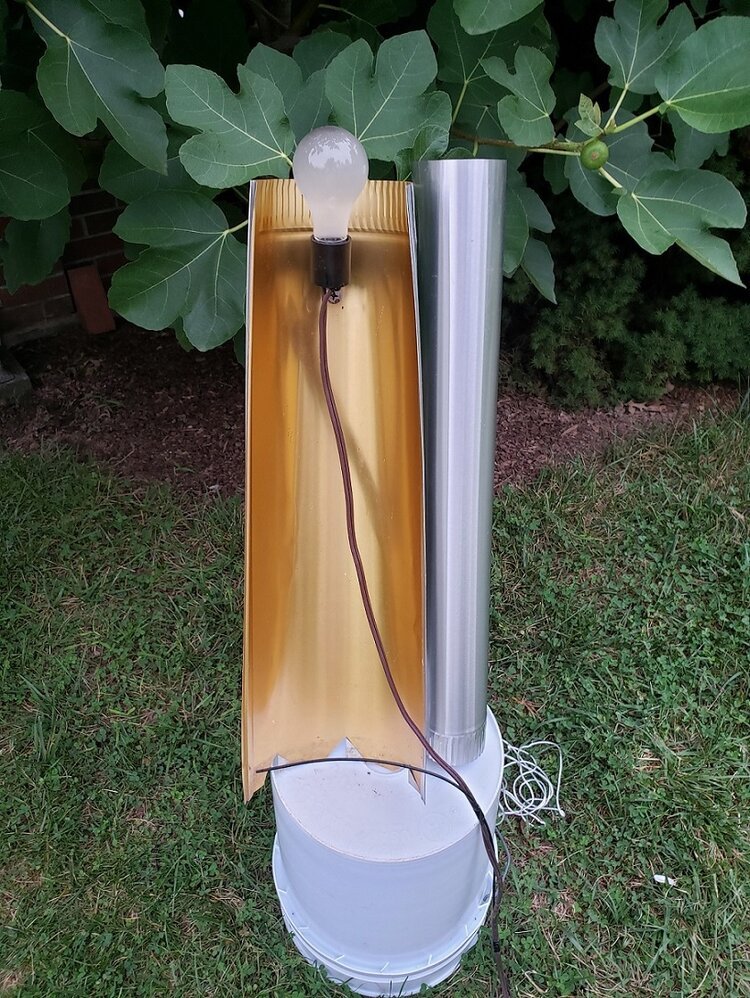
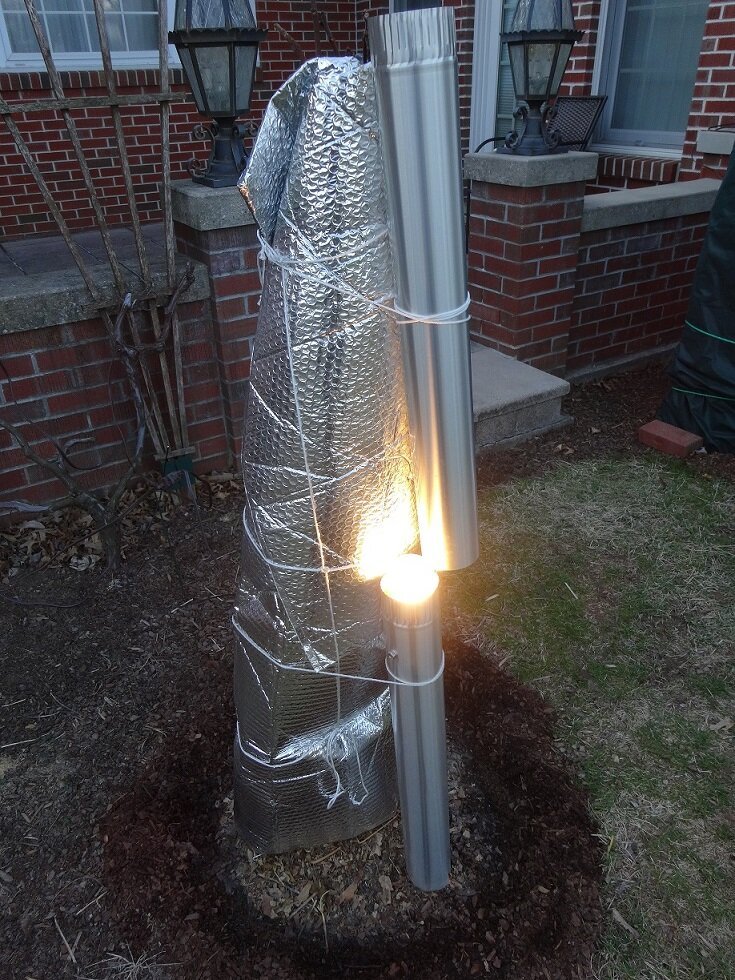
Overwintering Smaller Fig Trees

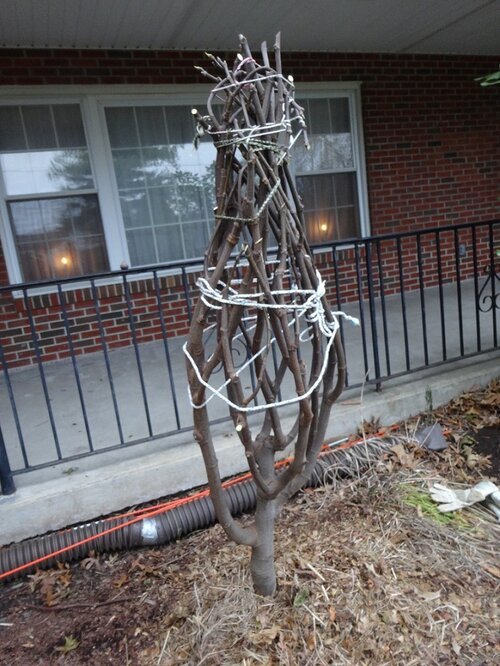
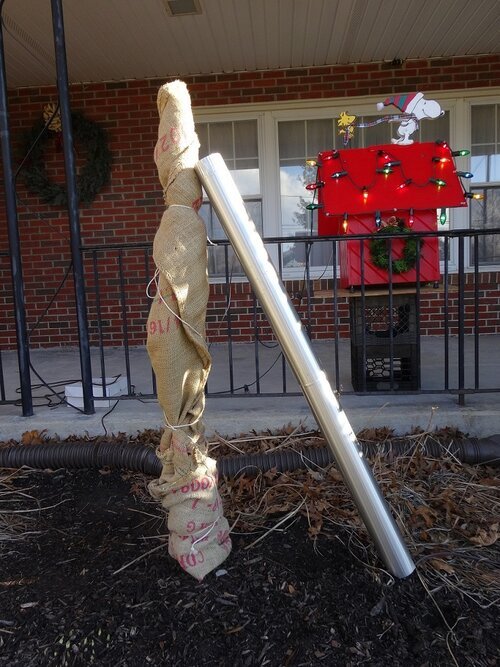
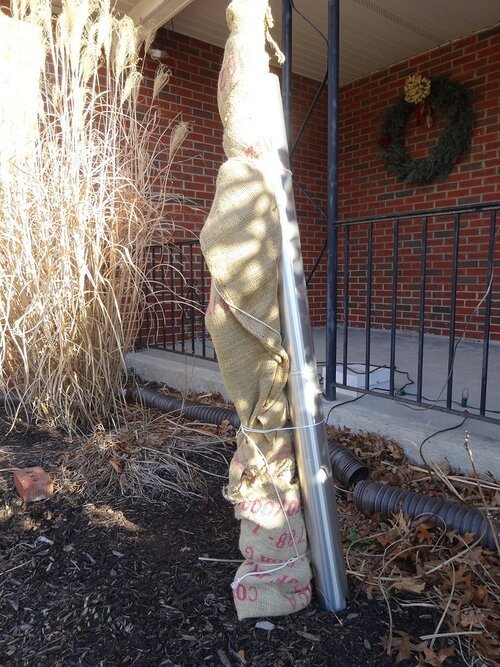
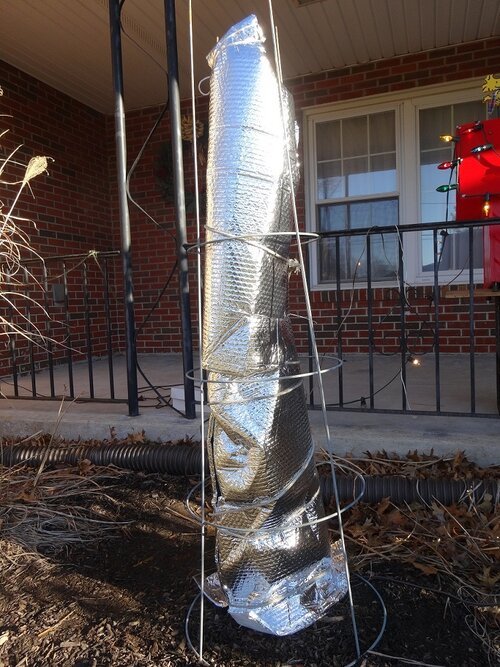
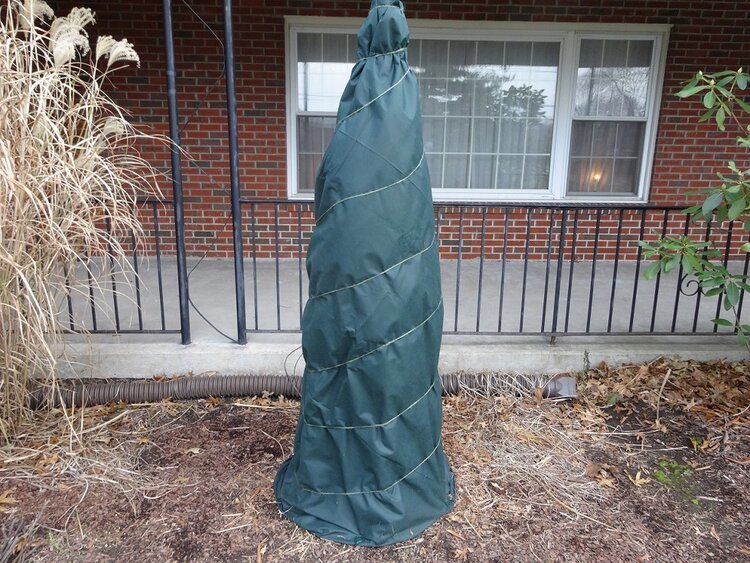
Overwintering Larger Fig Trees
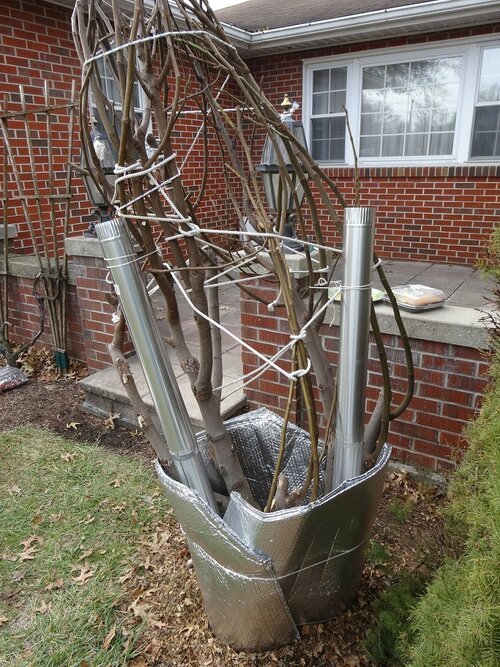
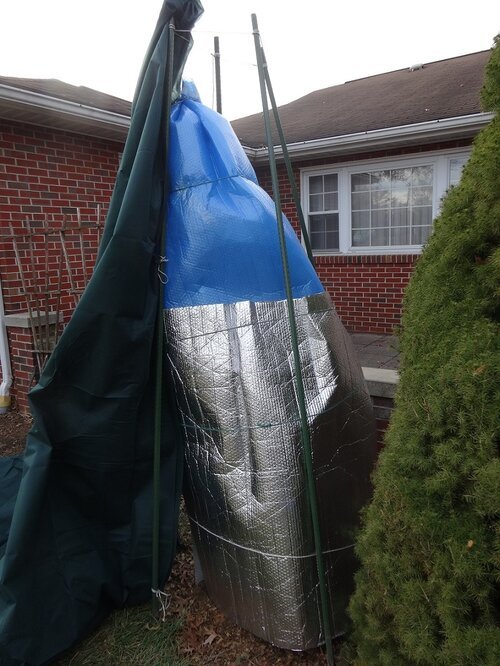
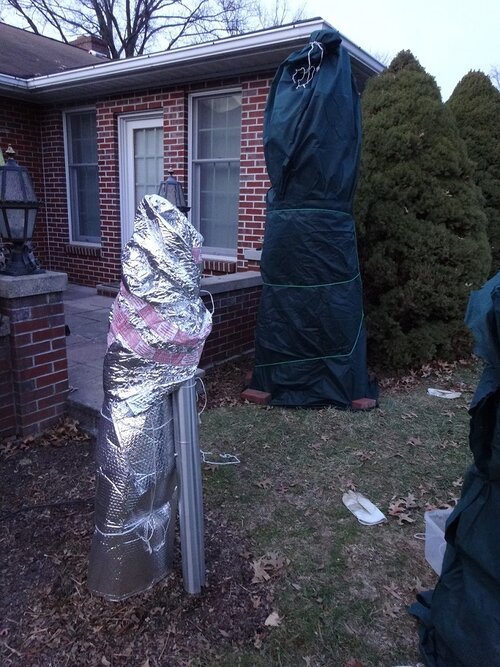
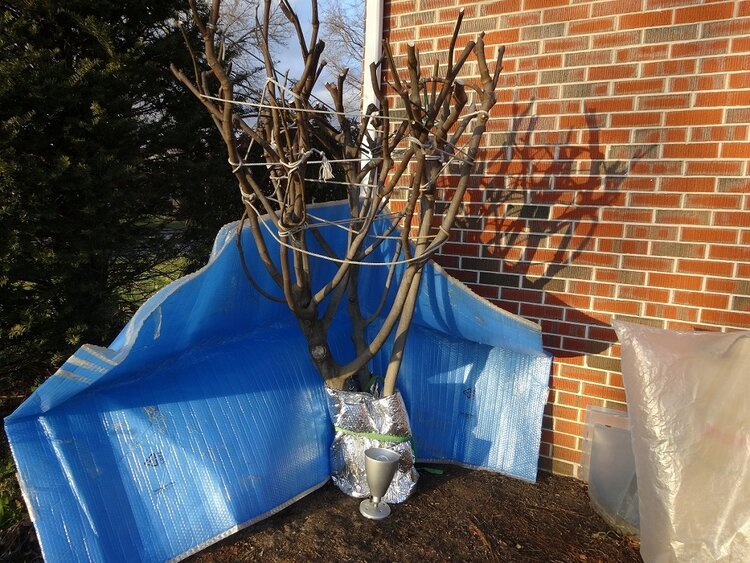
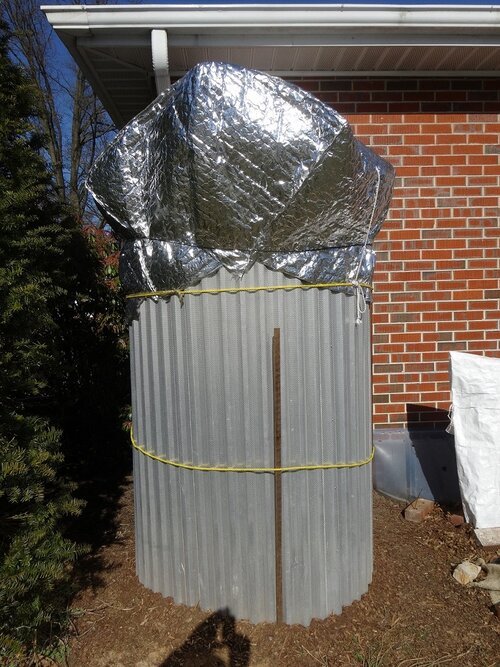
Top Tip for Growing Figs in Cold Climates
Things to think about as you decide how to overwinter your fig trees in a cold climate.
By Steven Biggs
My top tip when teaching people to grow figs in cold climates is to be creative.
My top tip: be creative and find an overwintering method that meets your needs.
Find a fig overwintering method that suits you, that ties in with your approach to gardening, and works with the features that you have around your property.
Here are things to think about as you decide how to overwinter your fig trees:
Your zone: How much protection your fig tree needs over winter depends on your plant hardiness zone.
Microclimates: Are there “microclimates” around your property? These are spots with conditions that are different from other parts of the garden. E.g. a south-facing brick wall that captures heat by day, and releases it by night.
You: The way that you decide to protect your fig over the winter will depend on how much lifting and schlepping you can deal with.
Your Property: Each house and yard is different. I once met a Toronto gardener with what he called a “fig cave”…a tunnel-like stairwell between his garage and his house, which was on a hill. It was ideal for him to overwinter his potted figs. Think about what options you have for overwintering figs around your property.
Your Budget: There are unusual gadgets for people who want to innovate when overwintering figs. (For example, I know a gardener with a thermostatically controlled outlet that runs the heating cable around his fig.) Other gardeners innovate using commonly available supplies.
Overwinter Figs on Balconies in Cold Climates
Ideas about how to overwinter dormant figs trees on balconies.
By Steven Biggs
Overwinter Figs on Balconies
I recently spoke with fig grower who grows figs on a condo balcony in Toronto...a small condo balcony where winters are cold!
I was so impressed with his creative approach to overwintering figs that I asked if I could share it. Here it is below, in his words.
I give my thanks to this fig pig (who prefers to remain unnamed) for sharing his experience!
Re: Overwinter Figs Where You Think You Can't: Fig Overwintering for Condos/Apartments
Hi Steve,
I read the excerpt from your book Grow Figs Where You Think You Can't about overwintering figs, and I applied the basic principles for a condo/apartment situation. I grow figs on my condo balcony in Toronto but have no yard (so no ability to earth-insulate), and no unheated garage or cold, dark room either.
Wooden planter lined with foam
My first year I had only 1 fig tree (about 2' tall). I took a rectangular wood planter box (approx. 3' x 1' internal) and lined it with Styrofoam (and cut out a Styrofoam lid too) to serve as an insulated container. I placed my dormant fig inside.
Since I planned to store it outside on my balcony over winter, I considered various heat source options (e.g. seedling heat mat, light bulb, coffee warmer, etc.). I ended up buying a small 7.5 watt flat oval fish bowl heater (meant to go under aquarium gravel), which I placed into a mason jar full of water that I put inside the insulated wood planter.
Aquarium heater in jar
The aquarium heater is my version of a DIY water radiator. It has the added benefit of the water jar acting as a thermal mass for heat energy storage and temperature regulation. That is, the water is slow to warm and slow to cool, so temperature changes are gradual and moderated. The other advantages of fish tank heaters are that they are 100% waterproof (so they're safe for wet environments) and they're inexpensive too. A seedling mat was my initial choice but they were far more expensive, plus they lack the inherent thermal mass storage and regulation properties of a water radiator.
The flat plasticized fish bowl heater I used the first year provides continuous heat (no thermostat) and it basically kept the water above freezing and about +5°C to +10°C above the ambient air temperature. Only on the coldest of Toronto nights (e.g. those -20°C nights) did it get a bit too cold, and I needed to wrap the whole container in extra blankets to add insulation.
Plastic cooler with dormant fig and heater.
The next year I bought 3 more figs and needed a larger container so I bought the largest picnic cooler I could find, a marine cooler intended for boaters. I also upgraded to a higher wattage glass fish tank heater with a built-in thermostat. I supplemented it with a thermostat controlled AC plug switch, a ThermoCube TC-3, which turns on AC power to the heater around 2°C ambient air temperature and turns it off around 7°C.
I managed to fit all 4 figs in the large cooler and placed the fish tank heater in a large glass jar filled with water, the power cord running out the top. I taped shut the glass jar top to prevent water splashing out when jostled. I set the fish tank heater thermostat to the lowest level but when paired with the ThermoCube TC-3, the ThermoCube on\off temperatures are the primary thermostat.
Because I needed to lay my figs flat on their side, to prevent dirt from falling out I wrapped the figs in scraps of old cotton bed sheets. Initially I tried plastic but I was concerned about the lack of air flow and felt it trapped too much moisture.
For peace of mind, I also bought an electronic wireless thermometer (ThermoPro, $20) which includes a hygrometer to measure humidity. The sensor component was placed inside the fig cooler and the display screen kept indoors for easy monitoring. That kept me from constantly worrying and wondering what was happening with my figs.
The first year's fish bowl heater was 7.5w and just $13 (Hydor 7.5w Slim Heater for Mini-Aquariums and Bowls up to 5 gal). The second fish tank heater was 200w and just $20 (Pawfly HT-2200 Submersible Aquarium Heater 200W with Thermometer and Suction Cup, 50 gallon).
In my experience, the 7.5w heater was slightly undersized for my DIY insulated wood planter (but it would depend on how insulated the container is and the 200w is certainly overkill even for the larger cooler since the cooler is well insulated. I would suggest anything above 25w would probably work, depending on water jar and container size, and on insulation level.
Having more power is fine as long as you have a thermostat-controlled AC switch such as the ThermoCube to prevent over warming. Most fish tank heaters are intended to maintain water temperature above normal room temperature, and the thermostat minimum on the 200w heater was 16°C. Even with the 7.5w heater and without the ThermoCube, I found I was unplugging it manually on days when the ambient outdoor air temperature was above freezing, and it stayed mostly unplugged beginning early spring.
Bottom line: using a ThermoCube removes the guesswork and the risk of over warming.
Also, since picnic coolers are quite well sealed when the lid is closed, I would recommend leaving the lid ajar to prevent excessive humidity build up and to provide more air flow. Since the fish tank heater is submerged in water, that might also provide an additional source of humidity depending on how well sealed the water container is.
I would recommend only a very light watering before placing the dormant figs inside the cooler as the humidity can remain high in such an enclosed space. In my case, I watered my 4 figs thoroughly before they went into the cooler and they were still moist months later when I took them out in the spring.
Anyway, that's my fig overwintering technique for condo living. I hope this helps others in similar circumstances. It's very satisfying to be able to grow (and overwinter) figs where I thought I couldn't, on a balcony in an urban northern climate. Thanks for the inspiration!
Items Needed:
Insulated container (e.g. picnic cooler) large enough to fit your figs
Fish tank/aquarium heater and water jar/jug
Thermostat controlled AC plug (e.g. ThermoCube)
Wireless electronic thermometer with hygrometer (optional)
Bury Fig Trees for the Winter
Laying fig trees over and mulching or burying them is a common way to protect them in cold climates.
By Steven Biggs
You Can Bury a Fig Tree
In the book Grow Figs Where You Think You Can't, I explain how you can overwinter your fig tree outdoors in a cold climate by burying it.
And depending where you live, you might not even need to bury it…sometimes laying it flat to the ground and mulching it heavily is enough.
Why Tip Them Over?
The air temperature fluctuates more — and more often — than the soil temperature. So keeping your fig close to the soil protects it from frequent and extreme temperature swings.
What it Looks Like
Here's what I say in the book:
When it comes to overwintering figs outdoors, the method most people seem to know is burying them. Earlier, I mentioned fig orchards on the outskirts of Paris, France. This is the sort of technique that was used there.
I call it the graveyard method.
I used to bury my lone fig tree, but this method is no longer practicable given the number of trees I have. But don’t discount this method if you haven’t a suitable spot indoors for dormant plants.
If you dig the hole deep enough, you can cover the plant with a layer of soil, although this is overkill in my area. A mulching material suffices here. If in doubt, deeper with more mulching and soil over top will be safer for your fig.
Here’s what you do:
Dig a trench on one side of your fig. It should be as long as the tree is tall. Where I live all that is needed is a trench just deep enough to bury it;
Tie together the branches once your tree or bush is dormant (this is so you don’t need to dig as wide a hole);
About 30 cm (12 inches) from the trunk on the side opposite to your trench, chop down with a spade to sever the roots, which will make it easier to bend over the plant;
Bend the plant so it lies in the trench, then weigh it down with something heavy or peg it into place;
Fill the trench with a thick layer of mulch, and cover with a tarp (you can cap this with a board and soil for additional insulation if you like).

